This is an in-depth beginner’s guide to homemade French macarons. This post includes a kitchen-tested recipe, plus plenty of success tips, descriptions, overview of techniques, list of tools, and links to my favorite macaron resources and other recipes on the web.
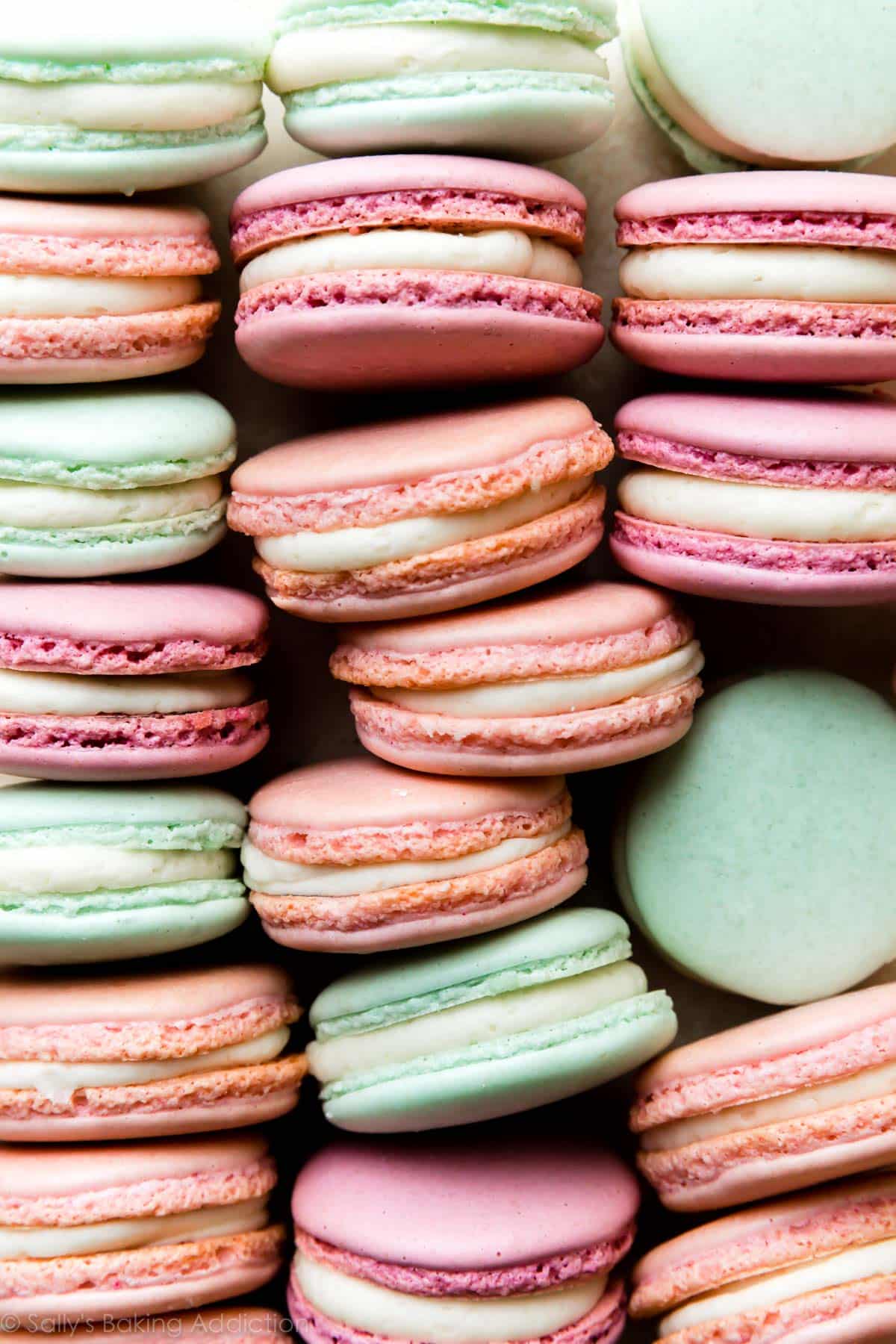
Let me start today’s tutorial with the following:
- Is this the one and only way to make French macarons? No.
- Is this the most complete, perfect French macaron tutorial out there? No.
- Is this a great place for macaron beginners? Yes.
Like many home bakers, I was a French macaron beginner a few years ago. These beautiful little cookies had always been a baking bucket list recipe for me. I started baking them after tasting the world famous Ladurée bakery macarons—talk about perfection! We originally published a French macaron recipe on my website in 2015. My homemade macarons weren’t nearly as flawless as the professional ones, but they worked for me at the time! However, the results weren’t always consistent. With 6 additional years of practice, I found a few small but very helpful improvements. Today’s recipe includes those updates.
Macaroons Are Not Macarons
Macarons and macaroons are two completely different cookies. Macaroons have an extra O in the name and are coconut cookies. Macarons are delicate sandwich cookies. Here are my coconut macaroons. See the difference? Though they are both cookies made with egg whites, they are much different.
They are both, however, gluten free dessert recipes.
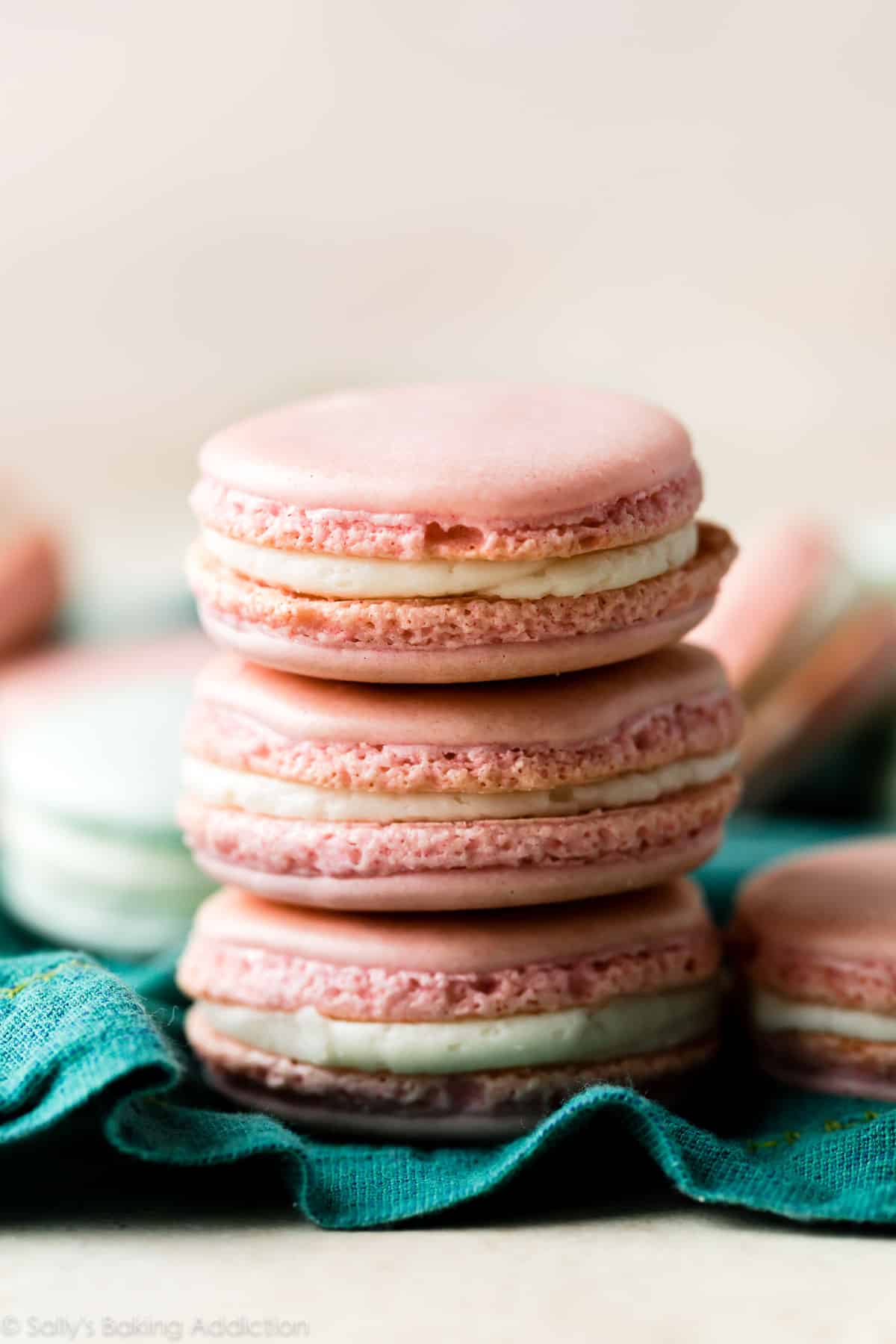
What Do These French Macarons Taste Like?
French macarons are delicate sandwich cookies with a crisp exterior. Each individual cookie is known as a macaron shell. The shells are made without any chemical leaveners and get all of their lift from properly beaten egg whites. If you follow the recipe carefully, the cookies have a unique nougat-like, chewy texture. They should not be hollow. You can flavor macarons many ways, but this recipe is for plain macarons. They taste like sweet almond—and they’re delicious! You can always have fun with different flavorful fillings such as vanilla buttercream, lemon buttercream, salted caramel, or chocolate ganache.
If there’s one thing to know before baking French macarons at home, it’s this: these cookies require precision, patience, and practice. I’m going to do my best to prepare any French macaron beginner. You can do this!
There are a few methods for making macarons including Italian, French, and Swiss. Swiss isn’t as common (I’ve never made them that way), but Italian macarons are pretty popular. The process is a little more involved than the French method, but the results are considered more reliable. If you’re looking for a recommendation, I really like these Italian macarons found on Chelsweets.
Today’s recipe uses the French method. You need 5 ingredients.
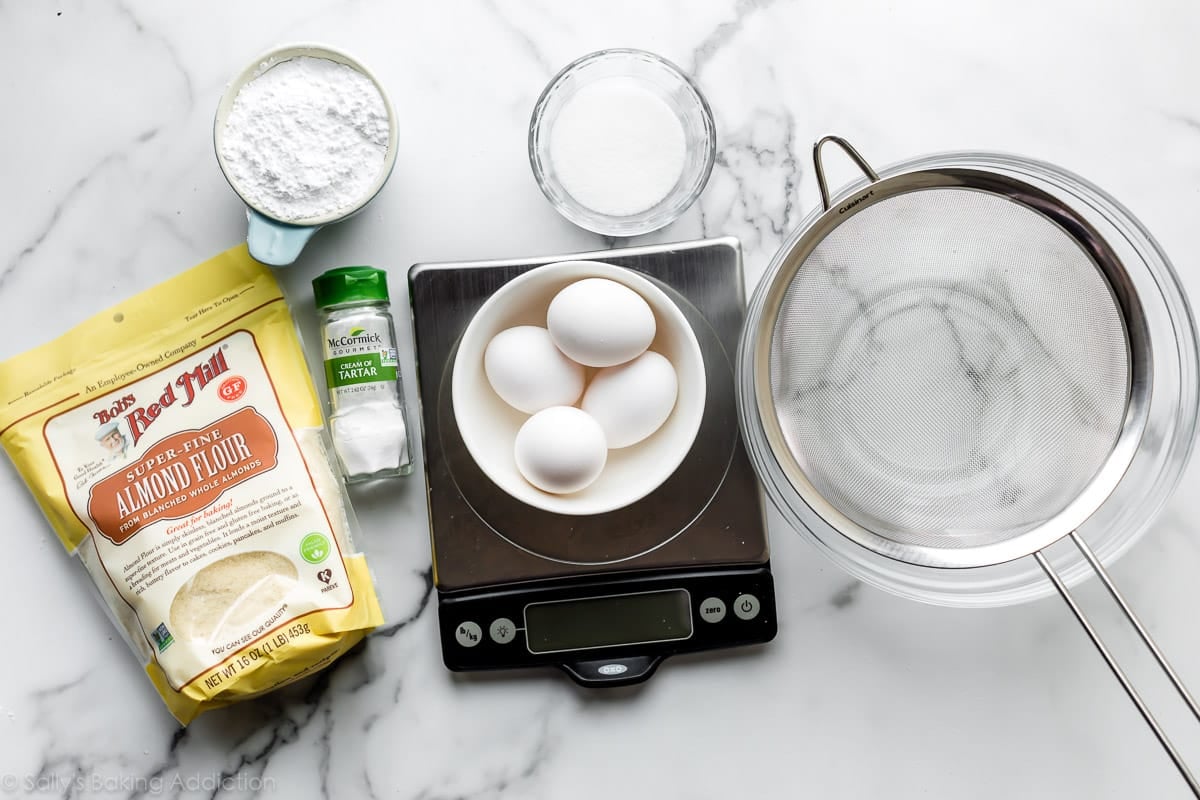
Overview of Ingredients in French Macarons
EGG WHITES: The bulk of French macaron batter is meringue made from properly beaten egg whites. For best and most consistent results, I strongly recommend using fresh egg whites instead of liquid egg whites from a carton. It’s imperative that NO egg yolks make it into the recipe. Like I taught you in our Swiss meringue buttercream recipe, any fat (yolk) in the egg whites will prevent them from reaching stiff peaks, a crucial step for the successful outcome in any French macaron recipe.
- Age The Egg Whites: It’s helpful to “age” the egg whites in the refrigerator for at least 24 hours prior to starting this recipe. Why? Egg whites that have been separated and set aside in advance have a chance to relax, which improves their elasticity during the whipping process. Elasticity is certainly beneficial when you’re trying to whip egg whites into a lofty volume. Some bakers skip this step, saying that it’s a waste of time but I’ll tell you this: most of my failed macaron batches did not include aged egg whites. I recommend taking the 5-10 minutes to separate your egg whites, cover, and refrigerate them 1 day in advance. It doesn’t hurt. Bring them to room temperature before you begin the recipe.
CREAM OF TARTAR: My old recipe doesn’t include this ingredient, but I started adding it after I began making successful batches of marshmallow meringue frosting and chocolate swirled meringue cookies. It just provides a little extra insurance. Let me explain: the acidity in cream of tartar helps the egg whites hold onto air and, like the sugar (explained next), helps prevent the egg whites from collapsing. If you’re making snickerdoodles or angel food cake, you already have this ingredient on hand. It’s sold with the spices.
SUPERFINE SUGAR: In 3 additions, beat superfine sugar into the egg whites + cream of tartar. Without sugar, the protein molecules in egg whites will collapse. What is superfine sugar? Well, it’s regular granulated sugar that’s ground much finer, but not quite as fine as confectioners’ sugar. It’s also known as caster sugar. Superfine sugar’s granules are the best size to provide optimal structure for French macarons. Granulated sugar is simply too coarse, while confectioners’ sugar dissolves too quickly in the egg whites.
- I have a hard time finding superfine sugar in my local grocery store, so I make my own by pulsing regular granulated sugar in a food processor or blender. It takes about 10 seconds—very easy.
FINE ALMOND FLOUR: Almond flour is the ONLY flour that works in this French macaron recipe, however if you have an almond allergy, you could try these nut free macarons by Stella Parks. (I have not personally tried them.) Make sure you use almond flour, not almond meal. Almond flour is much finer and made from blanched, skinless almonds. Almond meal is coarser and contains almond skin.
- You can make your own almond flour, but be very careful because almonds can quickly release their oils, clump up, and turn into almond butter. It might be easier to just pick up a bag of fine almond flour. It’s very common in mostly all grocery stores these days—I use and love Bob’s Red Mill brand.
CONFECTIONERS’ SUGAR: Confectioners’ sugar adds bulk and sweetness to macaron batter. In this new recipe, I use equal parts confectioners’ sugar and almond flour to produce sturdy, more reliably successful macarons.
GEL FOOD COLORING (optional): Tinting macaron batter is completely optional. If you don’t tint it, the macarons will be a natural beige color. (And you can have fun with a colorful filling.) Avoid using liquid food coloring because it will change the consistency of your macaron batter. Instead, use 1-2 drops of gel food coloring.
- In the pictured macarons, I made 3 separate batches and used dusty rose, aqua, and fuchsia.
- Powder food coloring should be fine, but I haven’t tested it. Use a very small amount.
Crucial Tools
This list contains affiliate links to the products we personally use and love.
- Glass or Metal Bowls: Plastic bowls are porous and can hold onto grease and residue, which will prevent your egg whites from whipping properly. Set yourself up for success by using glass bowls or metal bowls in this recipe.
- Egg Separator: Not crucial, but certainly helpful. Here is the egg separator I really like.
- Food Scale: The recipe below is written in grams, so a food scale is imperative. Anytime I make macarons using cup measurements, they fail. You can certainly find French macaron recipes online given in cup measurements, but for true accuracy (and so you don’t waste your time, effort, ingredients, or money), I strongly recommend using a food scale. Here is the one I own and love.
- Electric Mixer: An electric mixer is helpful for whipping the egg whites into stiff peaks. You can use a handheld or stand mixer (whisk attachment). I do not recommend whipping egg whites by hand. It requires a lot of arm muscle and at least 30+ minutes of mixing.
- Fine Mesh Sieve: To obtain a shiny and smooth macaron shell, you must run the almond flour and confectioners’ sugar through a fine mesh sieve. You can use a hand crank sifter if you have one, but I prefer using a mesh one.
- Piping Tip & Bag: You need a piping bag and tip to pipe the batter. You can use a disposable piping bag or reusable piping bag. (I use and love this reusable piping bag.) For the piping tip, use a round tip such as Wilton 12, Wilton 1A, or even Ateco 806. I use the same piping tip to pipe the filling, too.
- Baking Sheet & Liner: I own, love, and swear by these half sheet pans for baking all my cookies: Calphalon rimmed baking sheets and USA Pan half sheet pan. See more of my recommended baking pans on my Best Baking Pans page. It’s important to line your pan. You can use a silicone baking mat, parchment paper, or even a fancy macaron-specific silicone baking mat. I usually use sheets of parchment paper.
Video Tutorial:
Step-By-Step Photos: How to Make French Macarons
Do your prep work. This includes (1) making superfine sugar with a food processor if you can’t find it at the store. I always make my own—see recipe note. Prep work also includes (2) wiping down the bowl you’ll whip the egg whites in with vinegar or lemon juice. Grease or fat prevents your meringue from setting up. And finally, (3) age your egg whites as described above and in the printable recipe below.
Making superfine sugar:
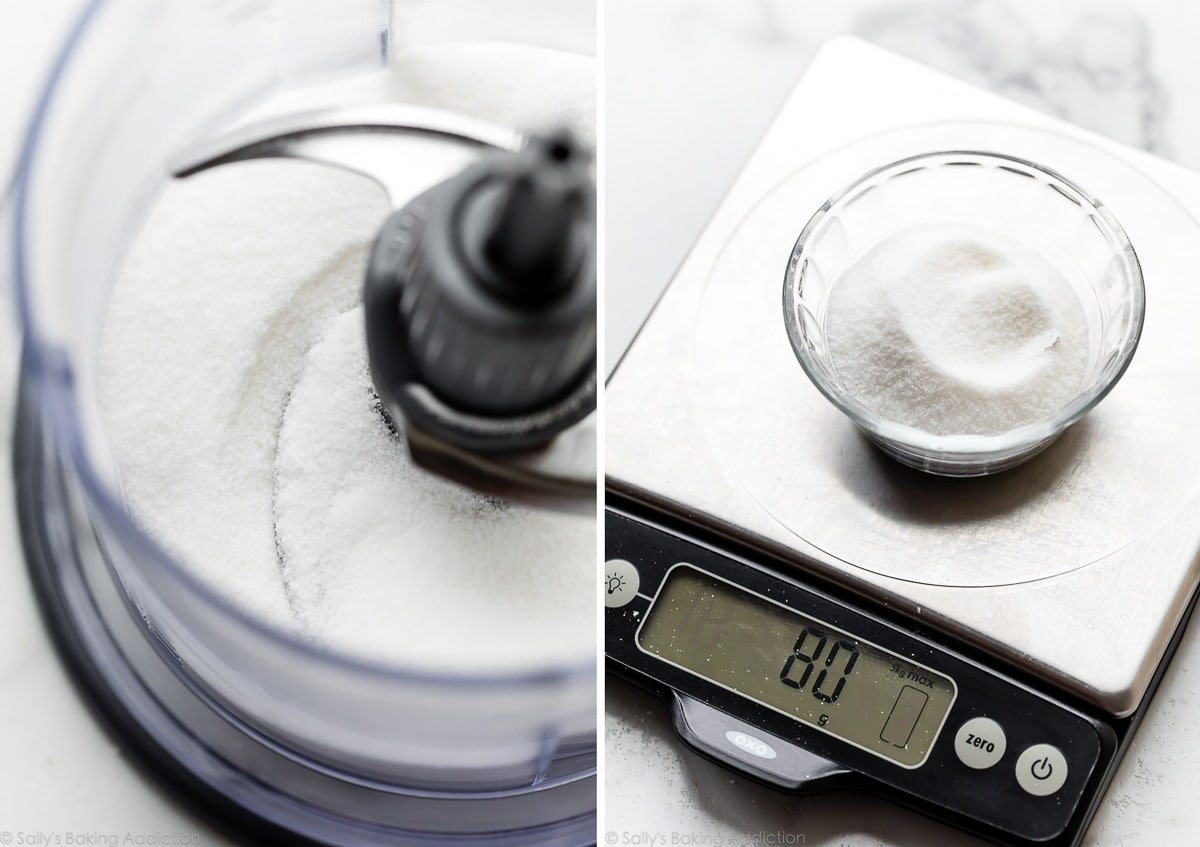
Zero out your scale, weigh your egg whites, cover, and refrigerate them for 24 hours. Bring to room temperature before using.
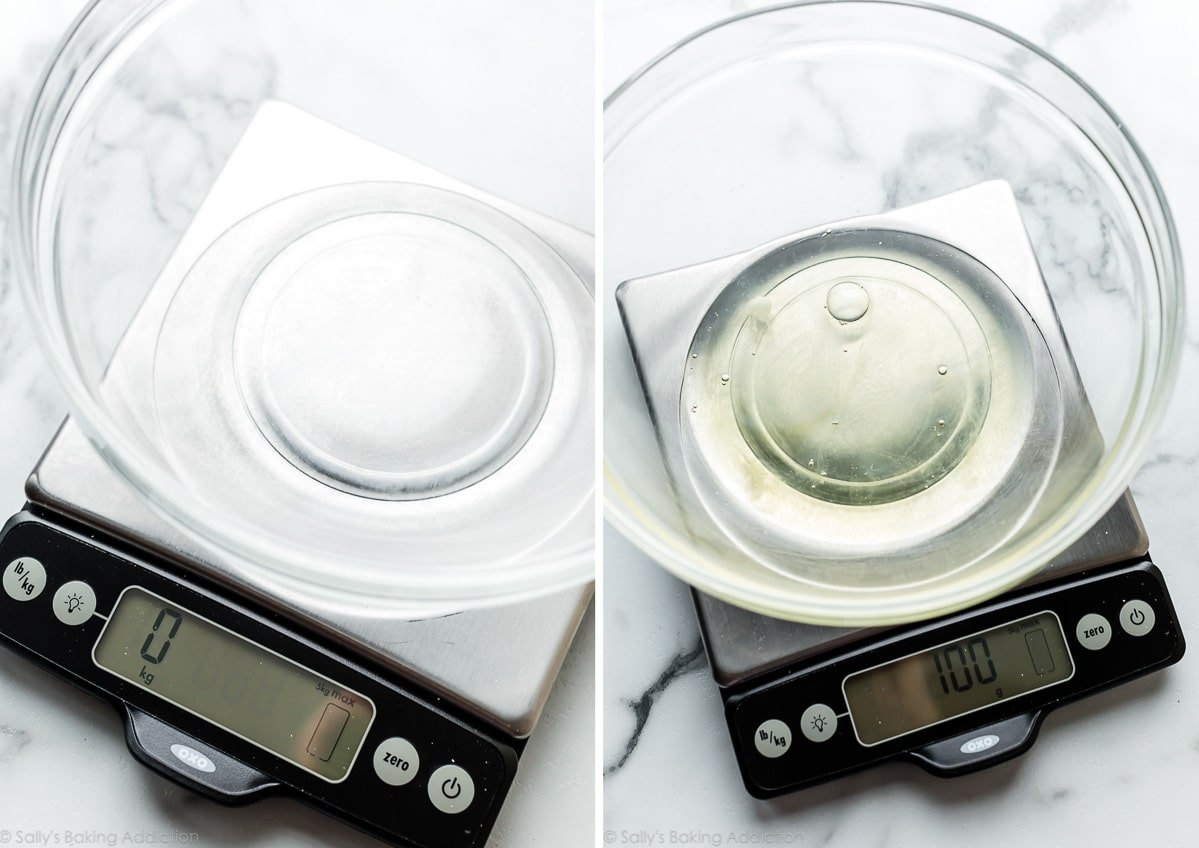
Now it’s time to start the macaron batter.
Add cream of tartar to your aged room temperature egg whites (below left) and beat until very soft peaks form. This takes a few minutes of beating. At first the egg white and cream of tartar mixture will be foamy, then the bubbles will begin to tighten and the beaters will leave tracks (below right) as the egg whites build volume:
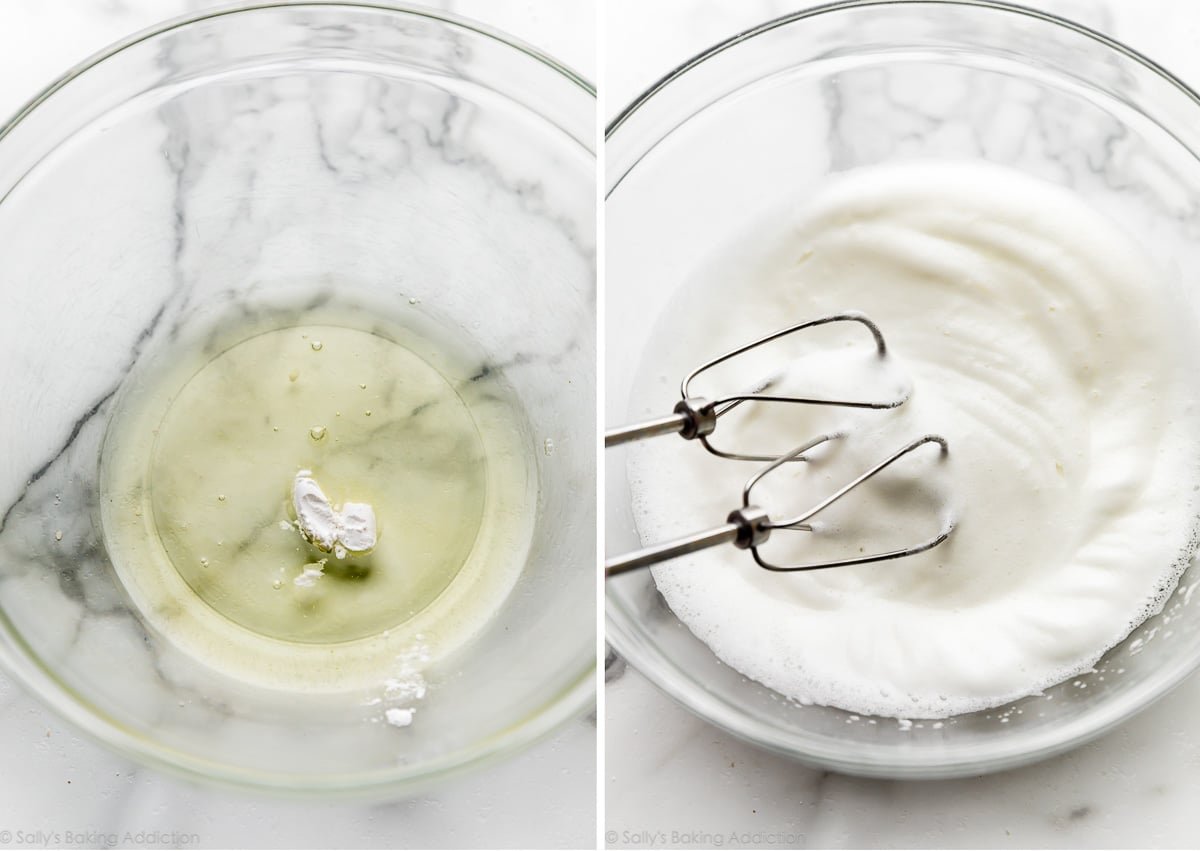
Now add your superfine sugar in 3 additions and beat until stiff glossy peaks form (below photos). What are stiff peaks? After several minutes of mixing in all the sugar, the egg whites will form stiff glossy peaks. This means the whites have stiff, smooth, and sharp points in the bowl or on the lifted whisk attachment/beaters. Stiff peaks do not droop down. You can literally turn the bowl upside down and the egg whites will not move or spill out. (You can watch me do that in the video tutorial.)
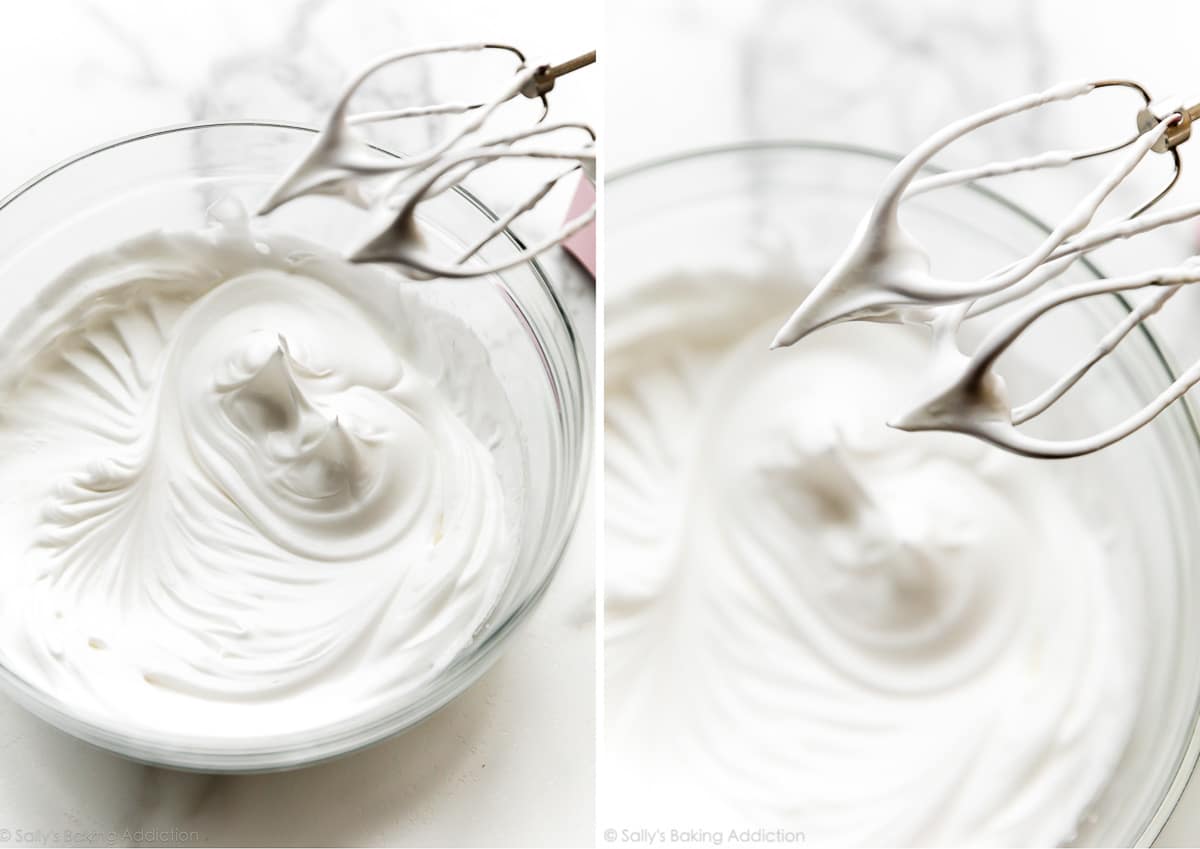
Now you can add your optional gel food coloring. It’s important to add gel food coloring to the egg whites directly, instead of the finished macaron batter. (Finished macaron batter more easily deflates.) Fold the coloring in very slowly. You can also beat in the food coloring with your mixer on a low speed.
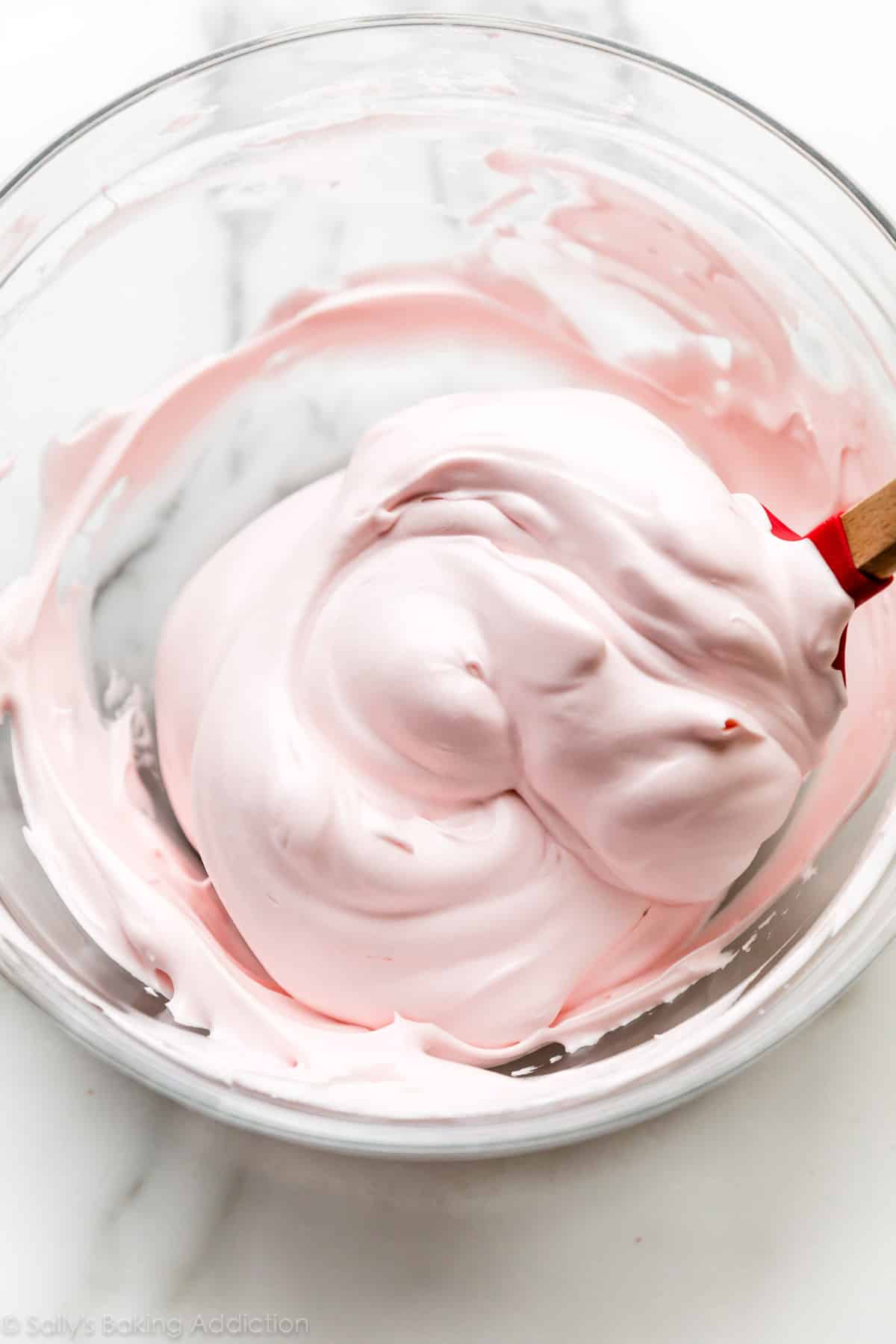
Set your stiff egg whites aside.
Sift the almond flour and confectioners’ sugar together in a large bowl. The bigger the bowl, the more room you have for the macaron batter, and the easier it will be to manage. Use a spoon to help work any larger pieces through the sieve. You don’t want to discard a lot of that because then you won’t have enough dry ingredients in the batter.
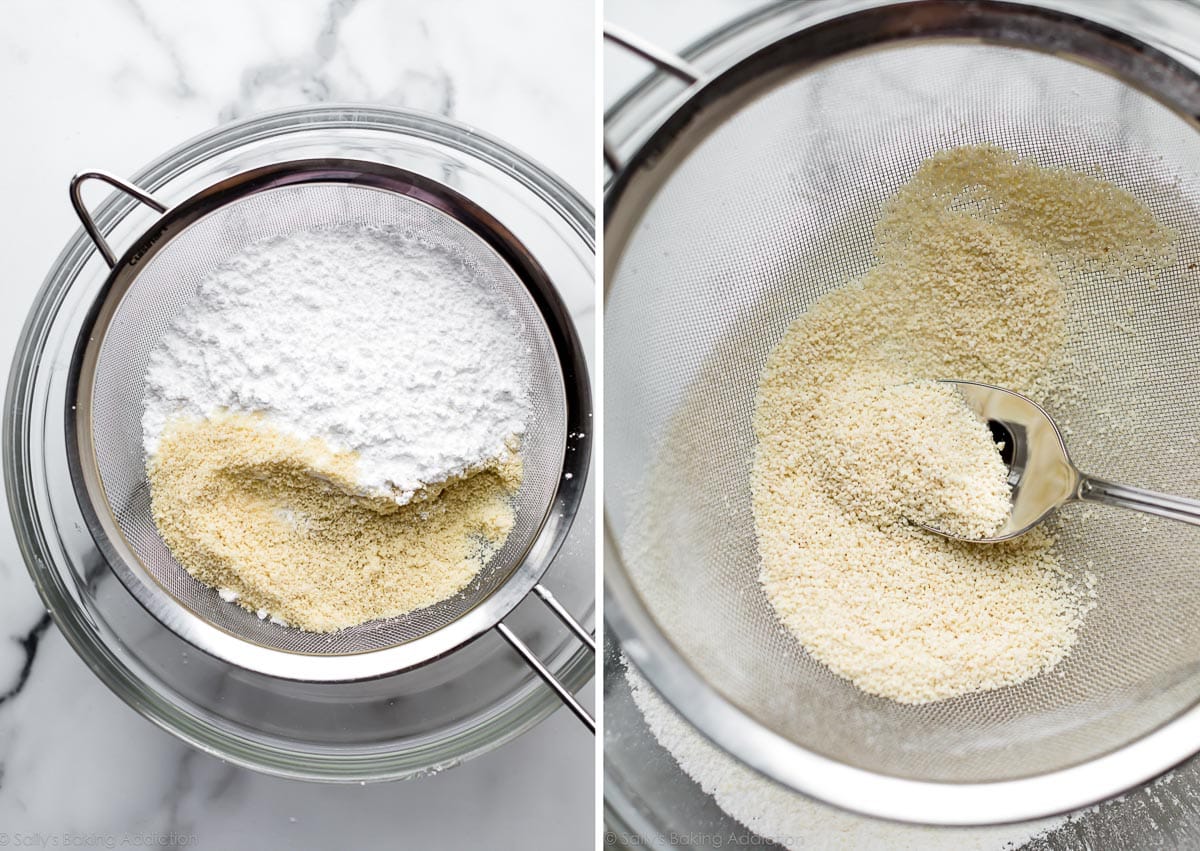
Sifting guarantees a nice light texture.
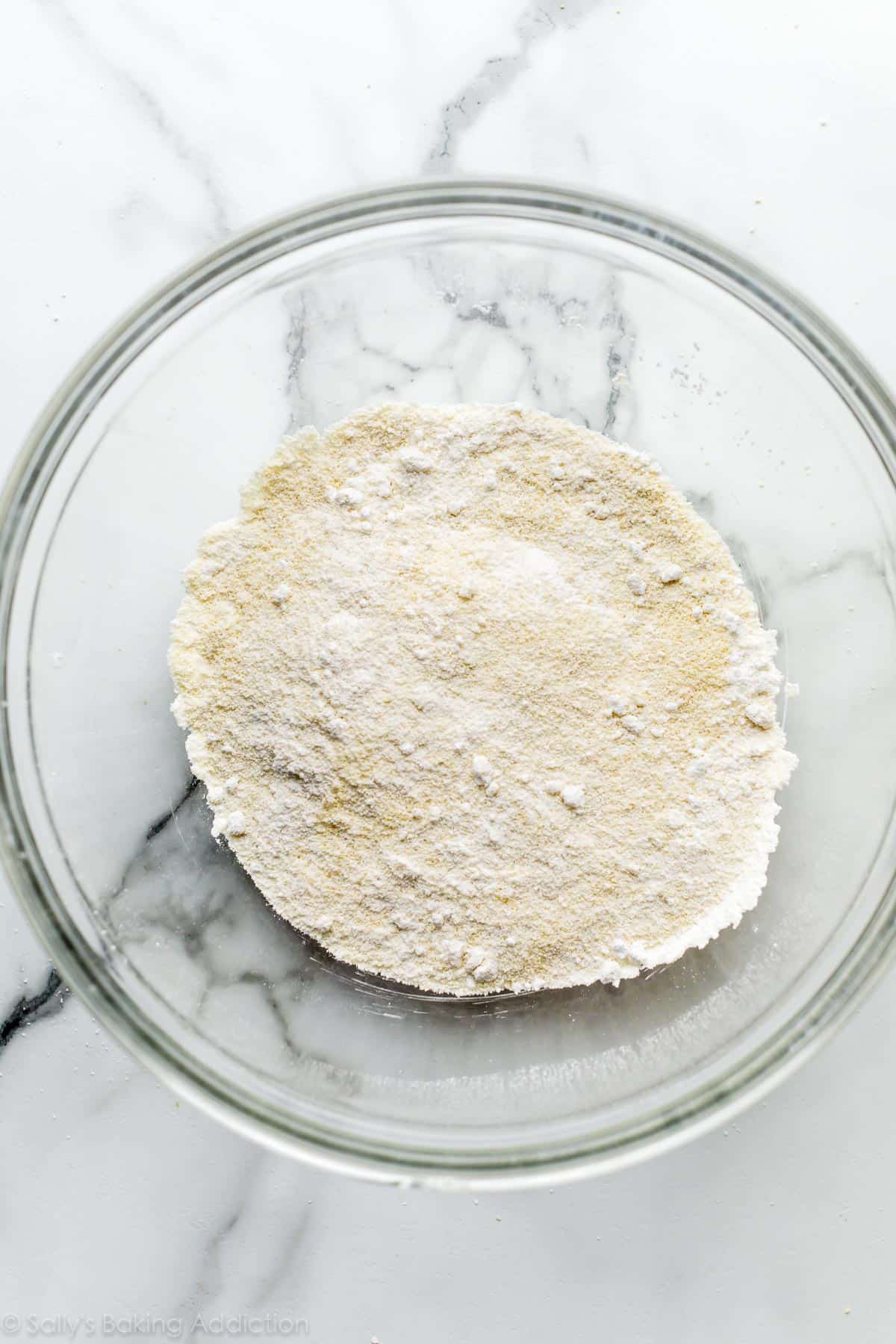
In 3 separate additions, begin slowly folding in the beaten egg whites in a circular motion. I always eyeball the amount. (Tip: The amount of egg whites you add at a time doesn’t have to be perfect because what you’re really looking for is the consistency of batter after the 3rd addition, known as macaronage and explained below.)
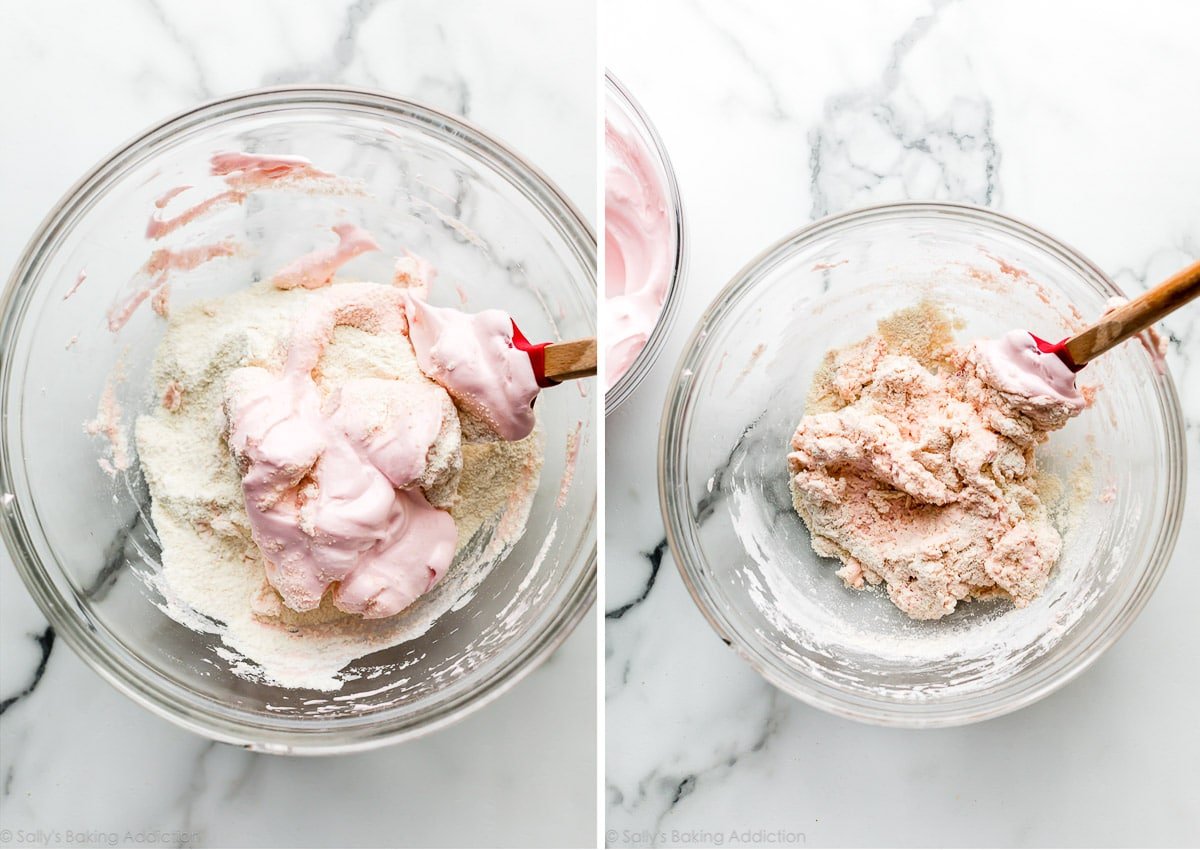
After only 1 addition, the batter will be very thick and dry:
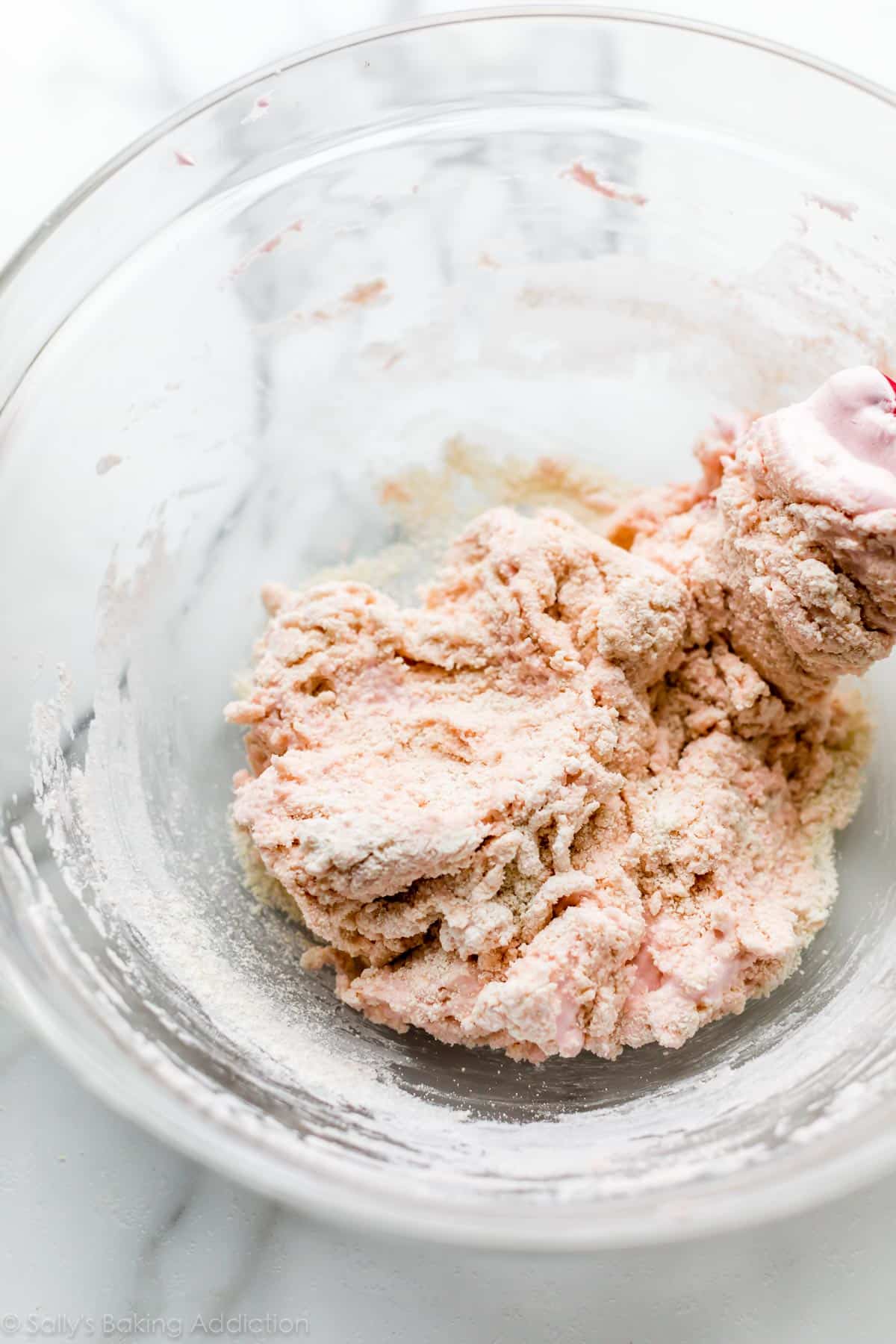
The batter will begin to loosen up after you add the 2nd and 3rd addition:
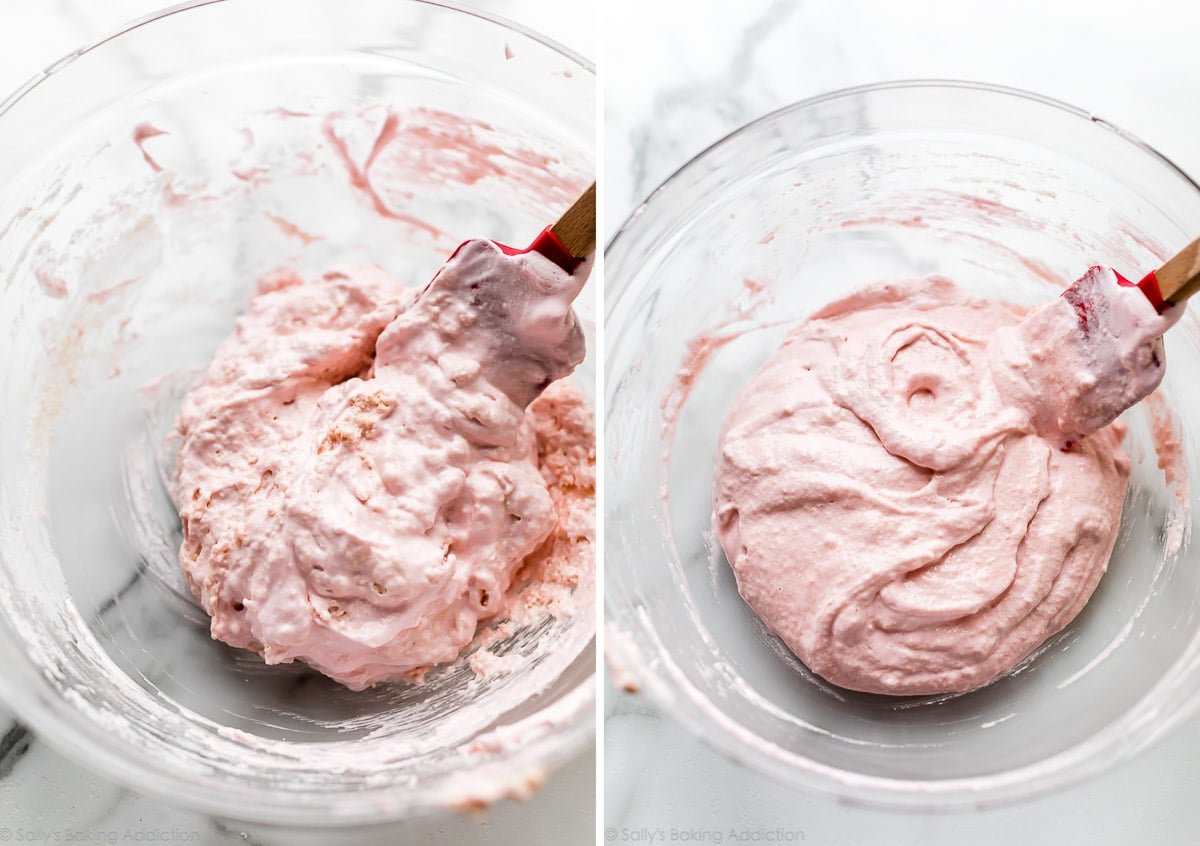
After that 3rd addition of egg whites, you’re at the macaronage stage. You need to keep folding and deflating air until you reach the perfect consistency.
What is Macaronage?
Macaronage is the process of working macaron batter into a shiny and flowy consistency that easily pipes into smooth macaron shells. You may have heard this term before and rightfully so—it’s a crucial step in this macaron recipe. During this stage, you want to be sure not to overmix or undermix the batter. Undermixed and thick batter can produce lumpy or hollow macarons. Overmixed and thin batter can produce cracked macarons or macarons without feet.
Balanced macaron batter after achieving that perfect macaronage is best understood through visuals. Use my video above as a guide starting at the 3:10 minute mark. The photo below should be helpful as well. Drop the macaron batter off of your spatula in the form of a figure 8. The batter will stream off of your spatula like honey and the figure 8 should take no more than 10 seconds to sink back into itself. If it takes less, your batter was overmixed and is too thin. If it takes longer, continue slowly folding the batter to deflate more air.
It’s best to go very slow so you don’t accidentally overmix.
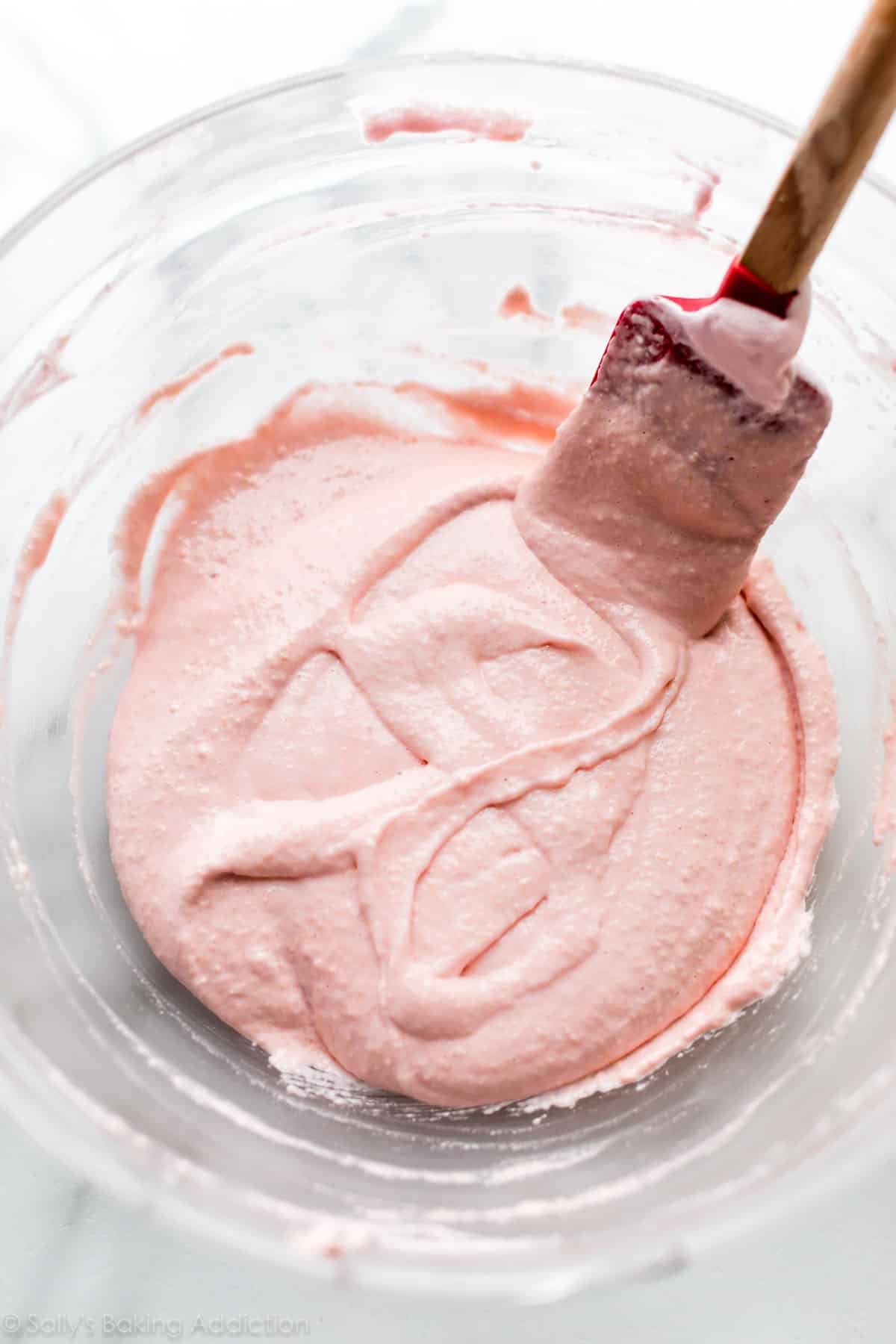
Spoon the macaron batter into your piping bag fitted with your piping tip.
How to Fill a Piping Bag with Macaron Batter
It can be pretty difficult to fill a piping bag with macaron batter since the batter is so drippy. My trick is to use a big cup and you can watch me do this in the video above. Fit the piping bag with a piping tip, then place it in a large cup, folding the top of the piping bag around the rim of the cup. Spoon batter inside, then lift the piping bag out of the cup and twist the end to seal in the batter.
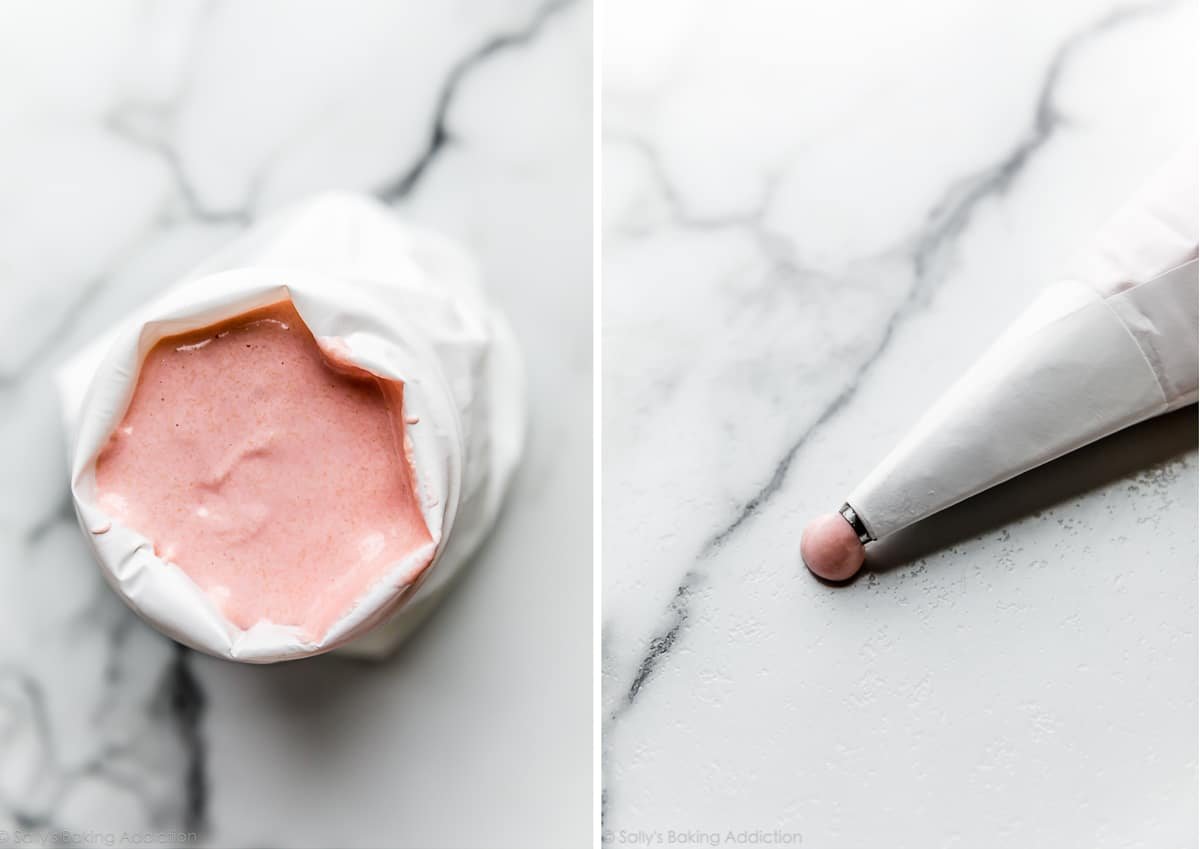
Pipe the batter in 1.5 inch or 2 inch circles at a 90 degree angle on the lined baking sheet. To guarantee your macarons are all the same size (helpful for sandwiching), it helps to have a template or drawn circles on your parchment. You can find free templates online—do a quick “macaron template” internet search—or purchase a macaron-specific silicone baking mat. I usually just trace something about 1.5 inches in diameter (like a medicine bottle cap or small round cookie cutter) with a pen on parchment paper then flip the parchment over. You can see the traced circle through the parchment, which makes an easy template for uniform circles.
Or just eyeball it! I promise no one will be offended by uneven macaron circles.
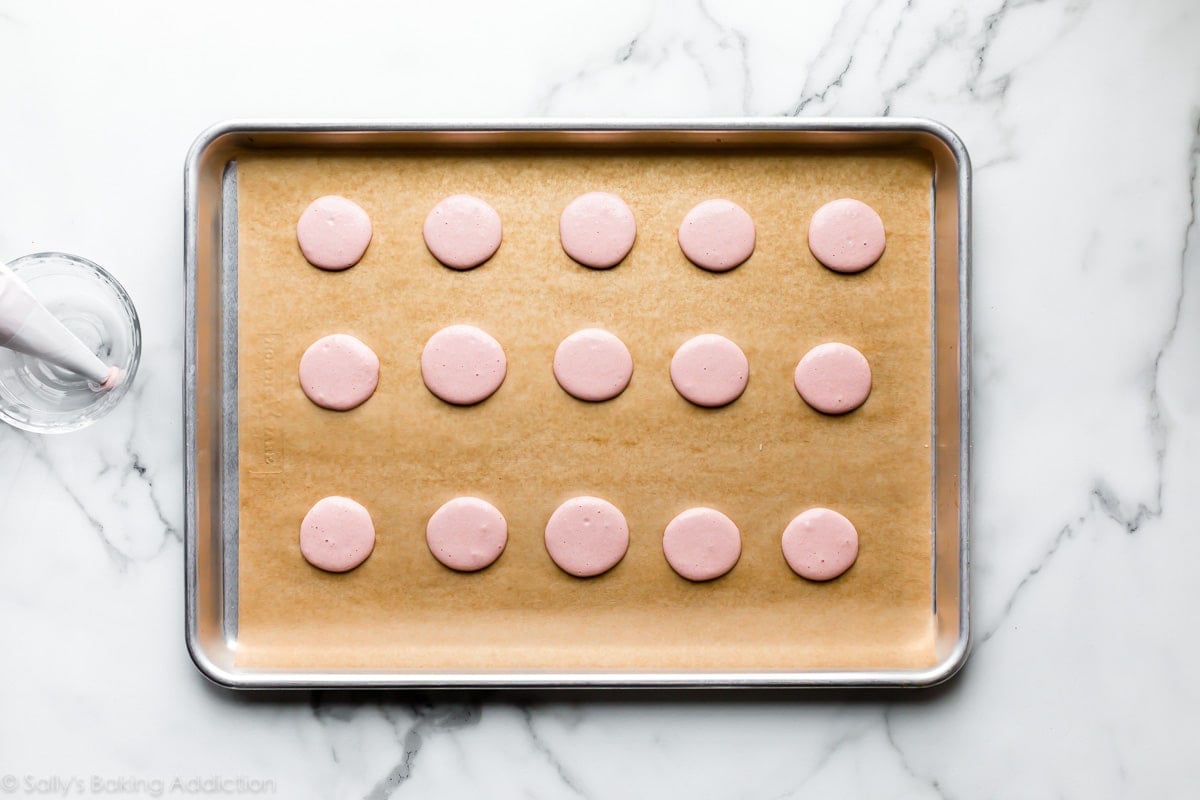
Bang your pan on the counter a couple times to pop any air bubbles. (You can see plenty of air bubbles before I popped them in the photo above.) Use a toothpick to pop any smaller air bubbles. Why is this necessary? Air bubbles will create cracks in your macaron shells. Pop any that you see.
Dry The Shells
There’s one more crucial step before you bake the shells. Let the piped circles sit out until they are dry and no longer tacky on top, usually 30-60 minutes. This time allows the top to firm up and form a skin, which helps the macarons rise UP and form their trademark ruffly “feet.” Your macarons will over-spread and will not have their signature feet if you skip this step.
Do not let them sit out for longer than they need to because they could begin to deflate.
It’s hard to tell in the photo, but these circles are no longer tacky on top and are ready to bake:
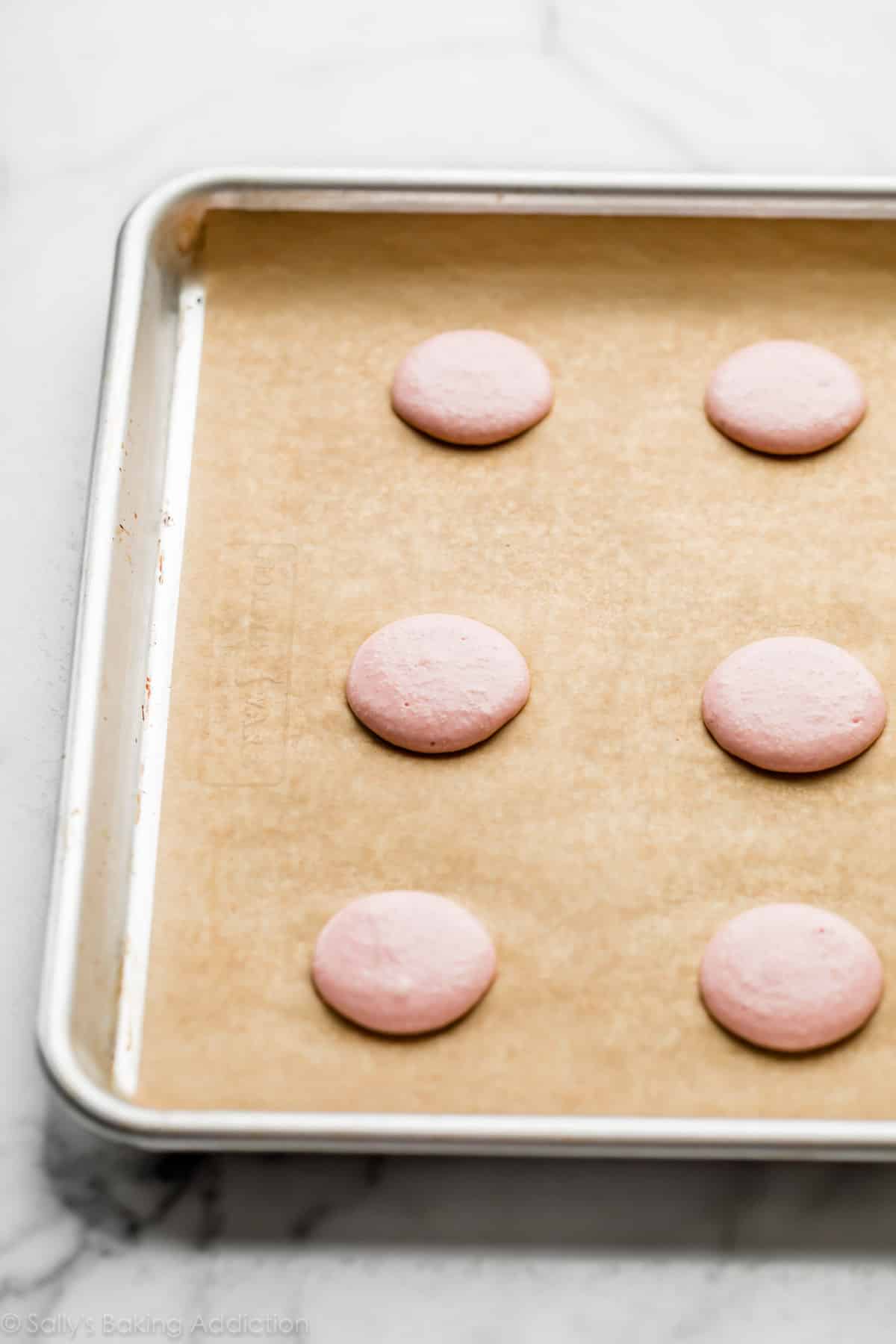
Bake at 325°F (163°C) for 13 minutes. All ovens are different and the actual temperature inside your oven may not match what the display reads. I highly recommend an oven thermometer.
Macarons Are Done Baking When…
As the macaron shells bake, they should form feet. To test for doneness, lightly touch the top of a macaron with a spoon or your finger (careful, it’s hot). If the macaron seems wobbly, it’s not done and needs another 1-2 minutes. If it seems set, it’s done. Basically, bake until the macarons don’t move around when touched.
Let the shells cool on the baking sheet for 15 minutes, then transfer to a cooling rack to continue cooling. The macaron shells may stick to the parchment paper/baking sheet if you try to remove them too early. If this is happening, let them cool on the baking sheet a little longer before removing.
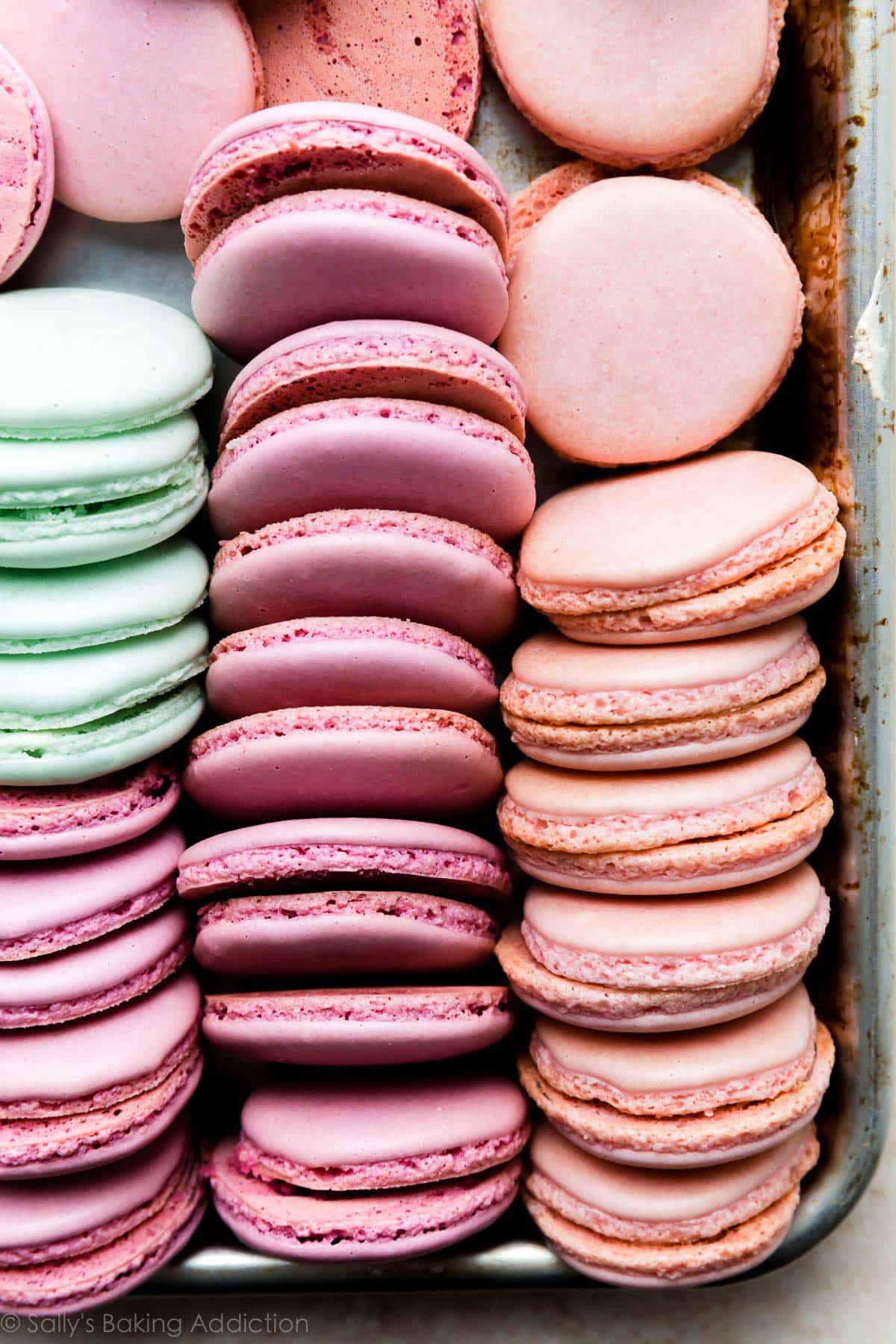
After cooling, the shells are ready to fill and sandwich together. I have plenty of filling suggestions in the recipe notes below. I usually halve my recipe for vanilla buttercream. You can spread the frosting on the underside of half of your macarons with a knife or you can use a piping bag/tip. Just use the same round tip you used for the macaron batter.
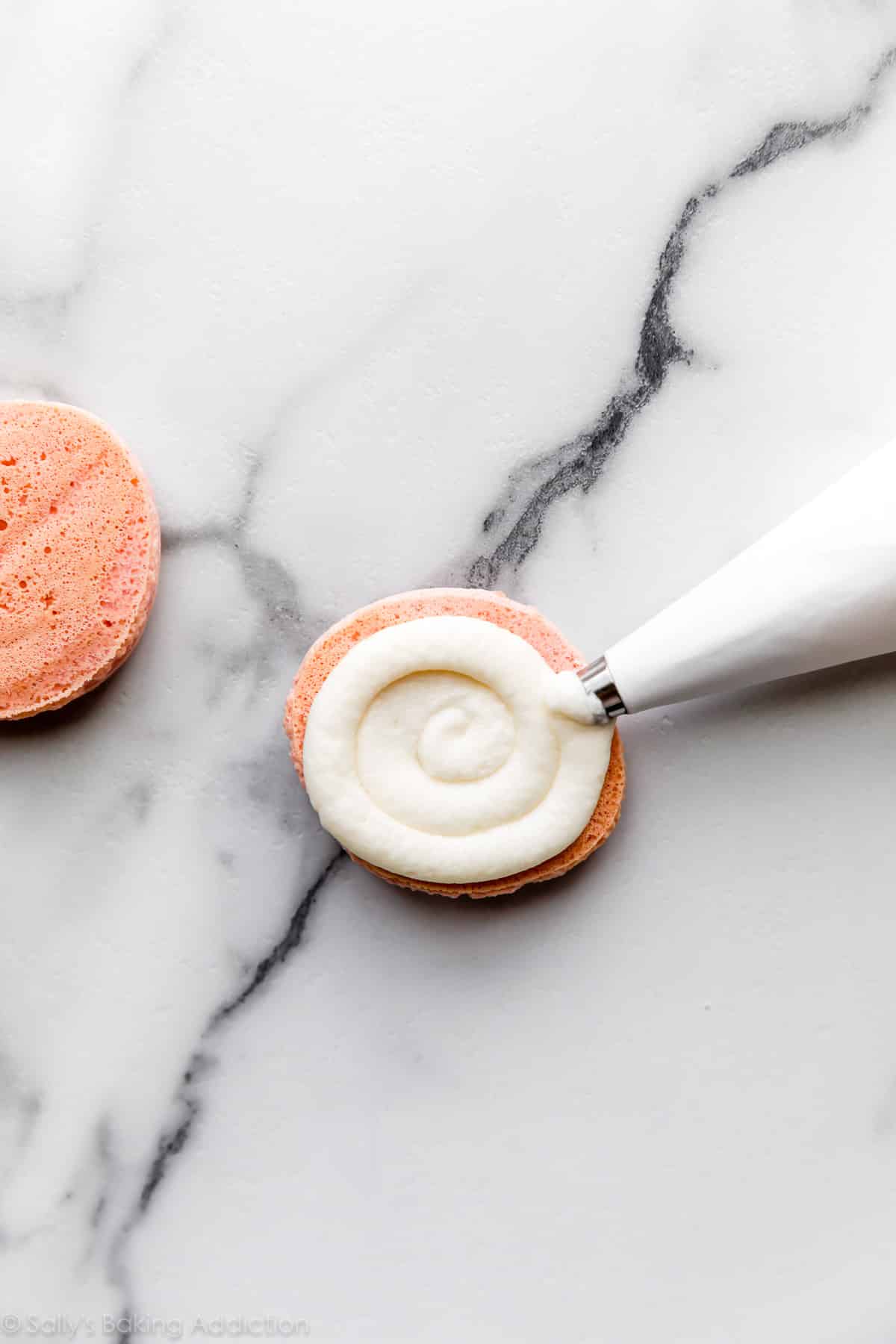
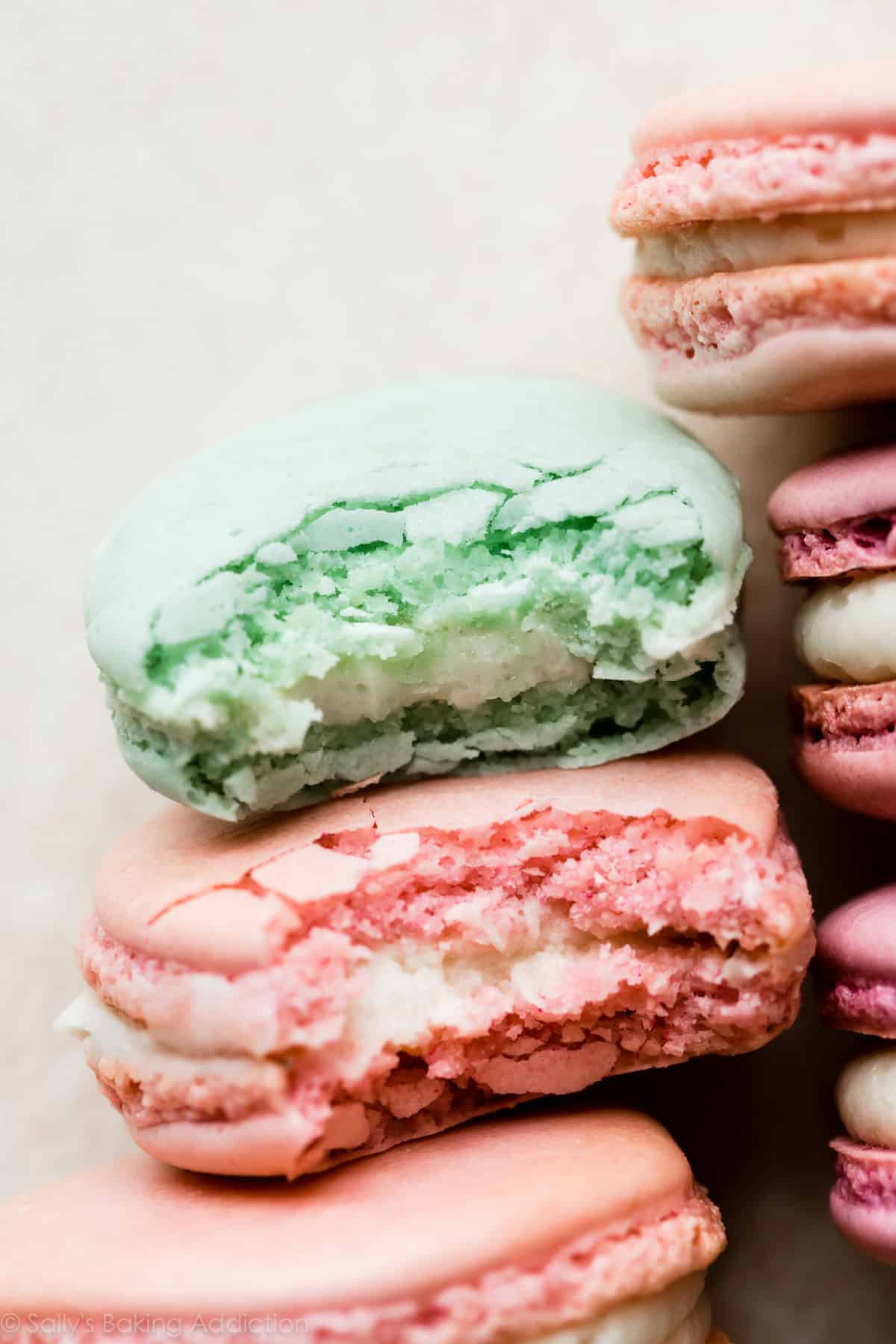
Troubleshooting French Macarons
- Hollow Macarons: It’s always so frustrating to bite into a macaron only to have it filled with… empty air. There are a few culprits leading to this disappointing outcome. If your macarons are hollow, the batter was likely undermixed or overmixed. Pay attention to the proper macaronage. Additionally, make sure you pop and air bubbles in the piped macaron batter as directed in the recipe. And finally, play around with your oven settings. The oven could be too hot or the macarons could be under-baked. All ovens are different and what some bakers find helpful is lowering the oven temperature down to 315°F (157°C) or 300°F (149°C) and extending the bake time by a few minutes.
- Macarons Have No Feet: Avoid over-beating the egg whites and over-mixing the macaron batter. Make sure you let your piped macaron batter dry/sit out before baking. It should no longer be tacky. See “Dry the Shells” above.
- Cracked on Top: If your macarons are cracked on top, they may have been over-baked, the batter may have been overmixed, air bubbles in the piped batter may not have been popped, and/or the egg whites may have been over-beaten.
- Runny Batter: Your macaron batter will be runny if you overmixed it, deflating more air than intended. Macarons baked with runny batter will over-spread, aren’t likely to develop feet, nor will they have the intended chewy texture. This is why the macaronage step is crucial. Fold the batter together slowly and perform the figure 8 test a few times until you have the correct consistency.
- Imperfect Piped Circles: Don’t get upset over this! My macaron batter is NEVER piped into perfect circles. You can even see in these photos that some are larger than others. Using a template helps, but so does practice.
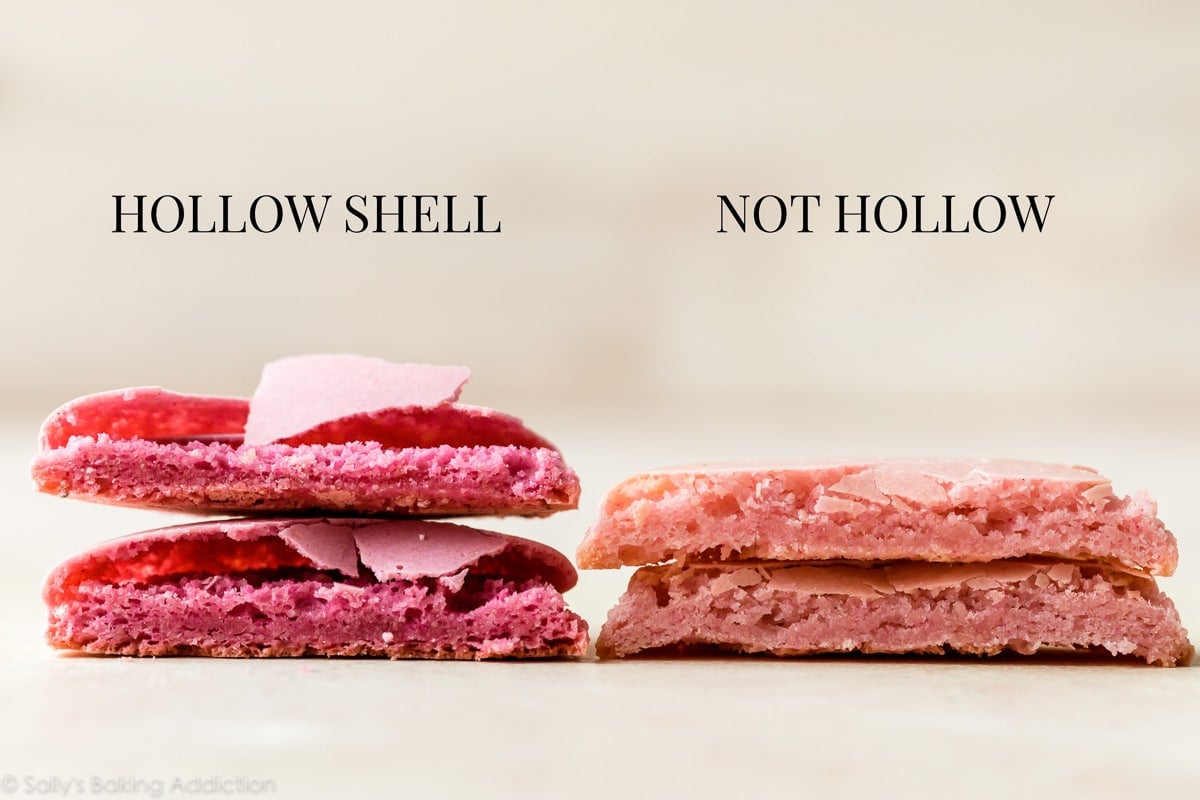
5 Final Success Tips:
- Wipe down your egg white bowl and beaters/whisk attachment with vinegar or lemon juice to rid any grease or fat residue.
- Use large metal or glass mixing bowls.
- Bake macarons on a dry day. If it’s particularly humid, the piped batter will take awhile to dry and the shells may not develop feet.
- Pay attention to proper macaronage, explained and shown above.
- Do not make any ingredient substitutions or deviate from the instructions.
So, Are These Worth the Effort?
Yes. But, of course, we all have different taste buds and levels of patience. Once you understand the process, they’re perfectly doable. And it’s a lot of fun to play around with different fillings. Have fun and don’t stress out. Even the ugly ones can be delicious. Just load them up with a filling and no one will care! 😉
Further Reading and Fun Flavors:
- Cookies and Cream Macarons and Pistachio Macarons from House of Nash Eats
- Lemon Macarons from Indulge with Mimi
- Ultimate French Macaron Guide by Mike Bakes NYC (so helpful!)
- Chocolate Hazelnut Macarons by Sweet & Savory by Shinee
- Macaron Troubleshooting by Sweet & Savory by Shinee (incredibly comprehensive and helpful)
- The Art of Macaron Making on Bob’s Red Mill
- Sprinkle Macarons by Cloudy Kitchen
- Chocolate Macarons by Sugar Geek Show
- French Macarons Recipe Guide on Bigger Bolder Baking (includes a template)
See Your French Macarons!
Many readers tried this recipe as part of a baking challenge! Feel free to email or share your recipe photos with us on social media. 🙂
Print
French Macarons
- Prep Time: 1 hour (plus aging egg whites)
- Cook Time: 13 minutes
- Total Time: 1 hour, 30 minutes
- Yield: about 40 shells; 20 sandwiched macarons
- Category: Dessert
- Method: Baking
- Cuisine: French
Description
Review this page, video, troubleshooting, and success tips and follow the recipe precisely for crisp, chewy, delicate French macaron cookies. Have fun with fillings! I provide some filling ideas in the recipe notes. We strongly recommend using gram measurements, but see recipe note if you do not have a kitchen scale.
Ingredients
- 100g egg whites (usually between 3–4 large egg whites)
- 1/4 teaspoon (1g) cream of tartar
- 1/2 teaspoon extract such as vanilla, almond, coconut, etc. (optional)
- 80g superfine sugar (aka caster sugar, see note)
- 1–2 drops gel food coloring (optional)
- 125g almond flour
- 125g confectioners’ sugar
- desired macaron filling (some options listed in notes)
Instructions
- Wipe down a large glass or metal mixing bowl with lemon juice or vinegar. Add egg whites. Cover and refrigerate for 24 hours, then bring to room temperature.
- Line 3 large baking sheets with silicone baking mats or parchment paper. Set aside.
- Add cream of tartar and extract (if using) to egg whites. Using a handheld mixer or stand mixer fitted with a whisk attachment, beat together on medium speed until very soft peaks form. This takes a few minutes of beating. At first the egg white and cream of tartar mixture will be foamy, then the bubbles will begin to tighten and the beaters will leave tracks as the egg whites build volume. Once they begin leaving tracks, you likely have soft peaks. Stop beating. Add about 1/3 of the superfine sugar. Beat on medium-high speed for 5 seconds, then with the mixer continuing to run, add another 1/3 of the sugar. Beat for 5 seconds, then with the mixer continuing to run, add the remaining sugar. Beat on medium-high speed until stiff glossy peaks form. (This means the whites have stiff, smooth, and sharp points in the bowl or on the lifted whisk attachment/beaters. Stiff peaks do not droop down. You can turn the bowl upside down and the egg whites will not move or spill out.) Using a rubber spatula, slowly and gently fold the food coloring (if using) into the egg whites.
- Sift the almond flour and confectioners’ sugar together in a large glass or metal mixing bowl. Use a spoon to help work any larger pieces through the sieve. You don’t want to discard a lot of that because then you won’t have enough dry ingredients in the batter.
- Slowly fold the beaten egg whites into the almond flour mixture in 3 separate additions, folding until combined before adding the next addition. After you add all of the egg whites, pay very close attention to the consistency of your macaron batter. Continue folding the batter (which deflates air) until it thins out into the consistency of honey. What’s a more helpful cue is the figure 8 test. Drop the macaron batter off of your spatula in the form of a figure 8. The figure 8 should take no more than 10 seconds to sink back into itself. If it takes less, your batter was overmixed and is too thin. If it takes longer, continue slowly folding the batter to deflate more air, then perform the figure 8 test again. It’s best to go very slow so you don’t accidentally overmix.
- Spoon the macaron batter into a piping bag fitted with a medium round piping tip, such as Wilton 12, Wilton 1A, or even Ateco 806. The macaron batter is very drippy, so transferring to the piping bag can be messy.
- Holding the piping bag at a 90 degree angle over the baking sheet, pipe batter in 1.5 – 2 inch rounds about 1-2 inches apart on prepared baking sheets. I usually pipe little mounds—see video tutorial above. The piped macaron batter flattens out. Bang the pan a couple times on the counter to pop any air bubbles, then use a toothpick to pop any remaining air bubbles.
- Let the piped macarons sit out until they are dry and no longer tacky on top, usually 30-60 minutes. This time allows the top to firm up and form a skin, which helps the macarons rise UP and form their trademark ruffly “feet.” Do not let them sit out for longer than they need to because they could begin to deflate.
- Meanwhile, preheat the oven to 325°F (163°C).
- Bake for 13 minutes. As the macaron shells bake, they should form feet. To test for doneness, lightly touch the top of a macaron with a spoon or your finger (careful, it’s hot). If the macaron seems wobbly, it’s not done and needs another 1-2 minutes. If it seems set, it’s done. Basically, bake until the macarons don’t move around when touched.
- Let the shells cool on the baking sheet for 15 minutes, then transfer to a cooling rack to continue cooling. The macaron shells may stick to the parchment paper/baking sheet if you try to remove them too early. If this is happening, let them cool on the baking sheet a little longer before removing.
- After cooling, the shells are ready to fill and sandwich together. I have plenty of filling suggestions in the recipe notes below. You can spread filling with a knife or pipe it using the same round tip you used for the macaron batter.
- You can eat right away or, as some professionals prefer, cover and refrigerate them 12-24 hours so the macarons and flavors can mature. Bring to room temperature before serving. (I usually just serve them right away!)
- Cover leftover macarons and refrigerate for up to 5 days.
Notes
- Freezing Instructions: Cooled macaron shells and finished assembled macarons can be frozen for up to 1 month. Thaw at room temperature before filling/serving.
- Special Tools (affiliate links): Electric Mixer (Handheld or Stand) | Glass Mixing Bowls or Metal Mixing Bowls | Egg Separator | Food Scale | Fine Mesh Sieve | Piping Bag (Disposable or Reusable) | Medium-Round Piping Tip (Wilton 12, Wilton 1A, or Ateco 806) | Baking Sheets | Silicone Baking Mat, Macaron-Specific Silicone Baking Mat, or Parchment Paper | Cooling Rack
- Ingredient Substitutions & Weights: I do not recommend any ingredient substitutions in this recipe. Using weights (and a food scale) is the best way to guarantee success. However if you do not own one, use the following approximate measurements: for the superfine sugar, use 1/3 cup. For the almond flour and confectioners’ sugar, you need about 1 cup + 1 teaspoon each.
- Egg Whites: For best and most consistent results, I strongly recommend using fresh egg whites instead of liquid egg whites from a carton.
- Extract/Flavoring: I keep these macarons plain. Without flavoring, they have a sweet almond flavor. However, if desired, feel free to add 1/2 teaspoon of your favorite extract such as almond, vanilla, coconut, lemon, etc.
- Make Your Own Superfine Sugar: Add 80g of regular granulated sugar to your food processor or blender. Pulse about 10-15x until granules are much finer, aka superfine sugar. Weigh 80g superfine sugar—should be about the same amount you started with.
- Optional Food Coloring: Tinting macaron batter is completely optional. If you don’t tint it, the macarons will be a natural beige color. Avoid using liquid food coloring because it will change the consistency of your macaron batter. Instead, use 1-2 drops of gel food coloring. (I used dusty rose, aqua, and fuchsia.) Powder food coloring should be fine, but I haven’t tested it. Only use a very small amount.
- Almond Flour: Make sure you use almond flour, not almond meal. It is usually labeled as “fine” almond flour. Almond flour is much finer than almond meal and made from blanched, skinless almonds. Almond meal is coarser and contains almond skin. You can make your own almond flour, but be very careful because almonds can quickly release their oils, clump up, and turn into almond butter. It might be easier to just pick up a bag of fine almond flour. It’s very common in mostly all grocery stores these days– I use and love Bob’s Red Mill brand.
- Macaron Filling Ideas: The pictured macarons are filled with vanilla buttercream (I prepared a half batch). Other ideas are a 1/2 batch of chocolate buttercream, lemon buttercream, chocolate peanut butter frosting, Nutella frosting, cream cheese frosting, champagne frosting, strawberry frosting, or a full batch of peanut butter frosting. Cooled and thickened chocolate ganache or cooled salted caramel are great, too!
Adapted from Les Petits Macarons and Mad About Macarons


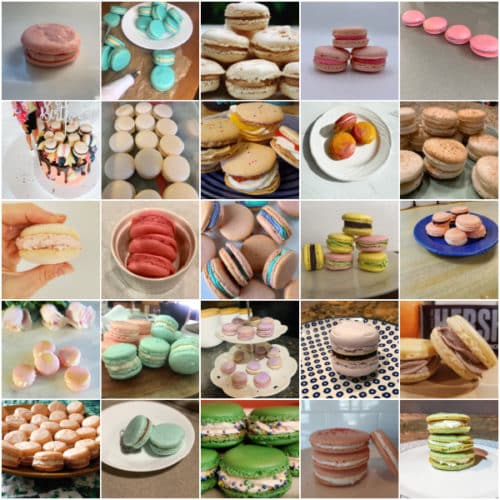
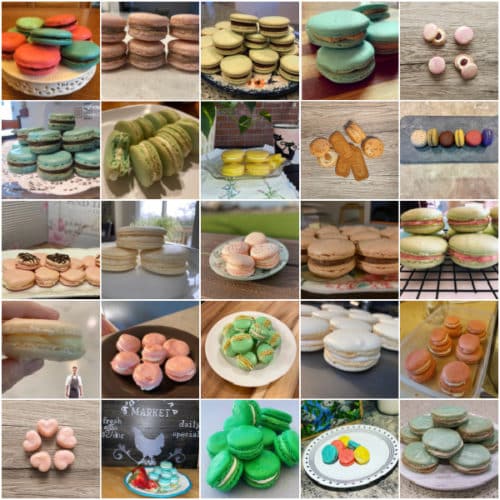
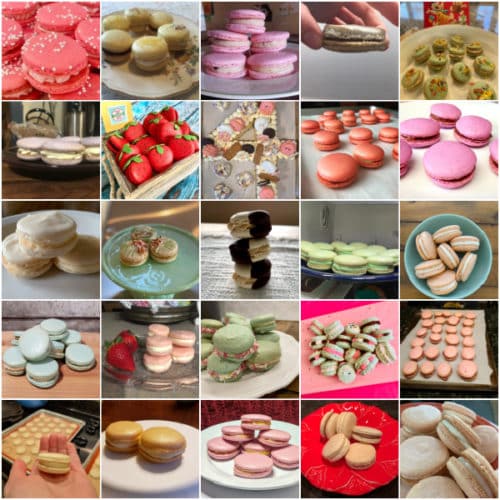
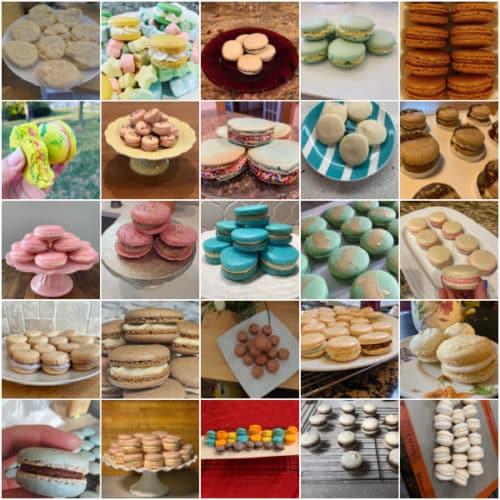
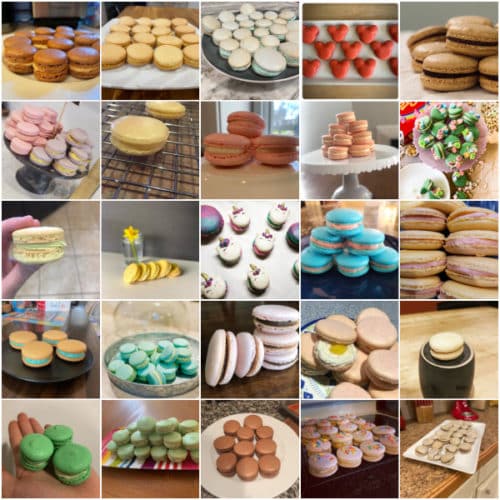
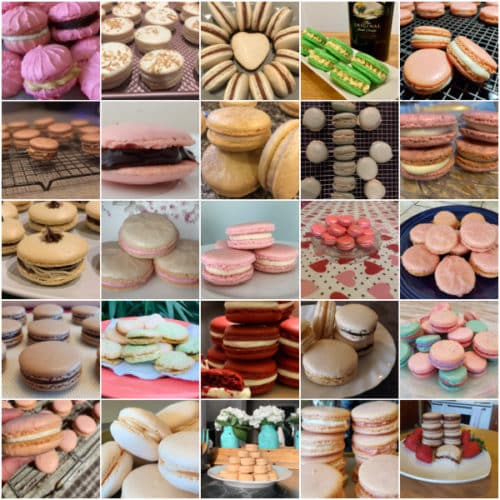

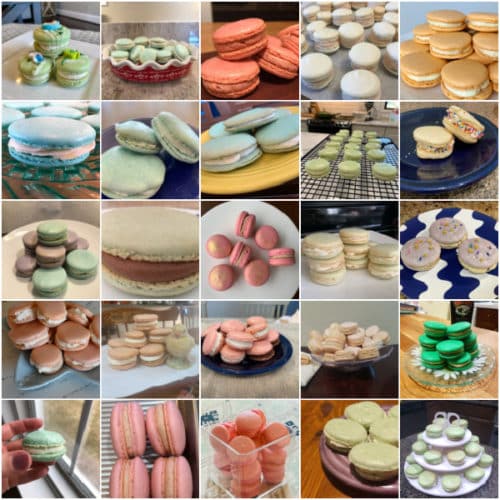
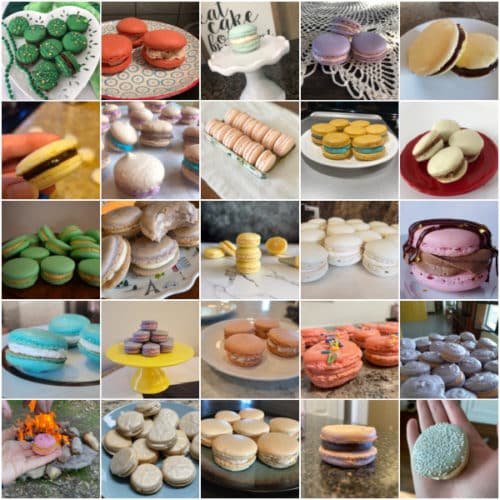
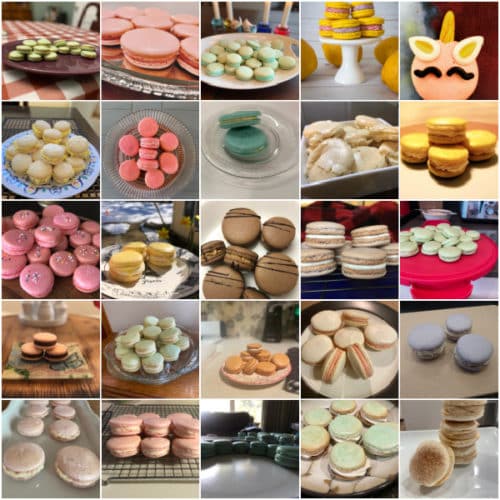
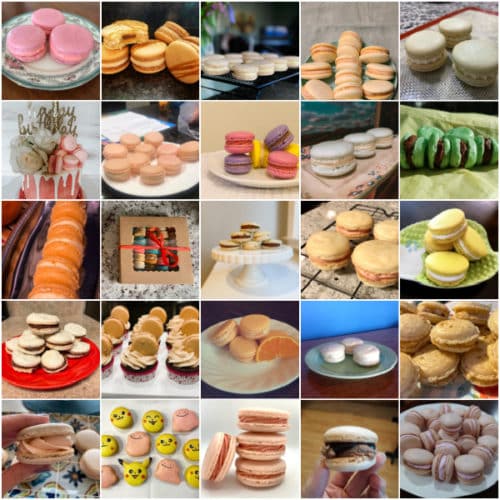
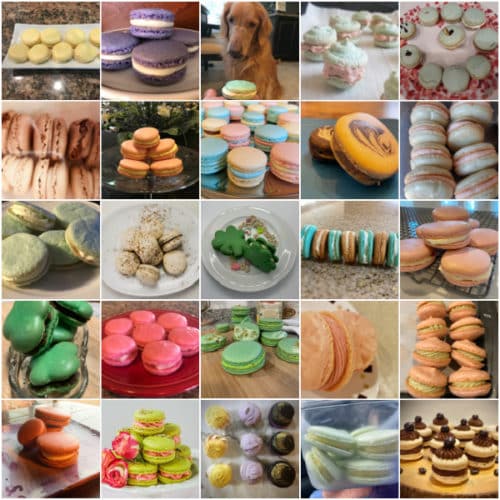
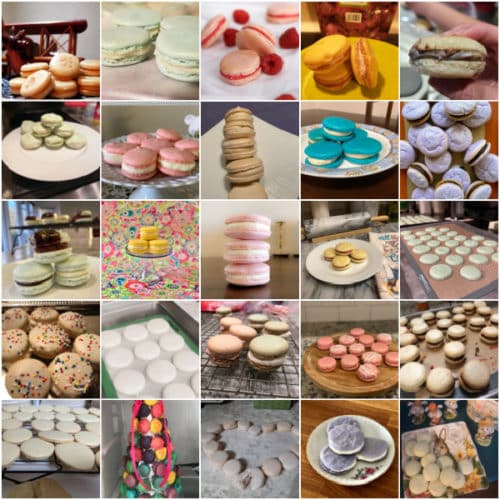
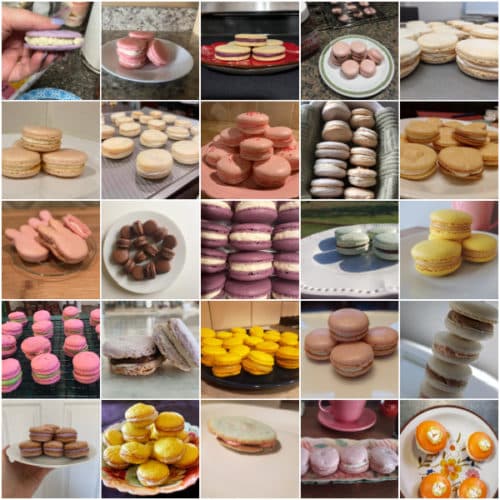
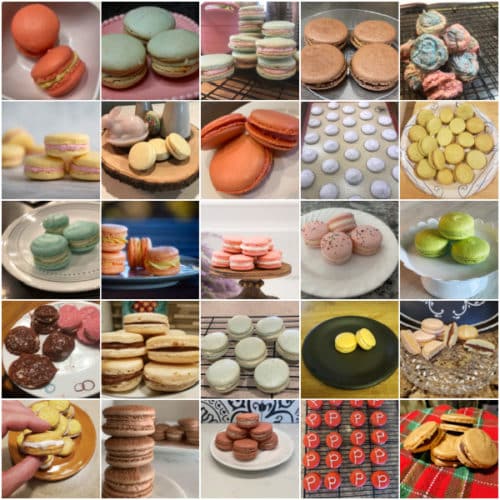
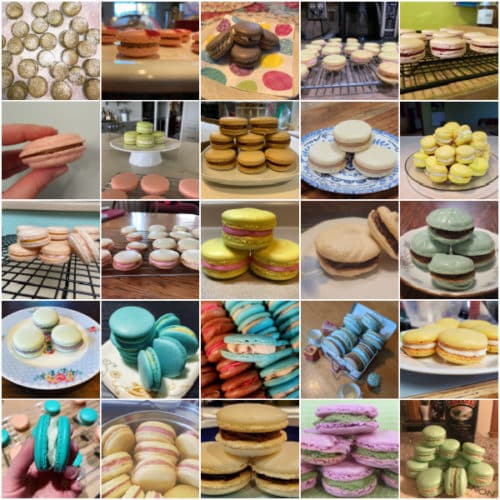
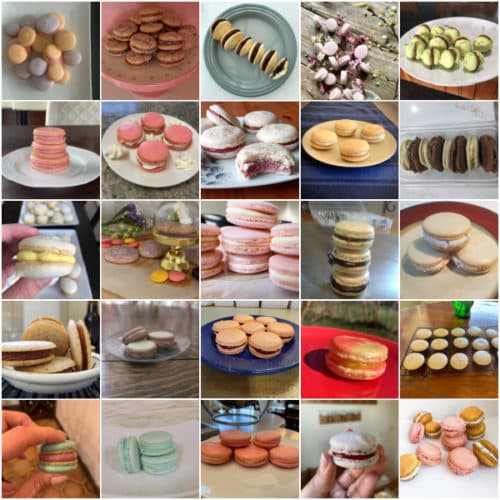
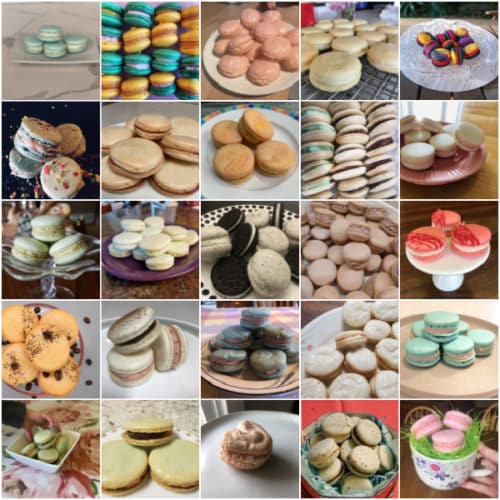
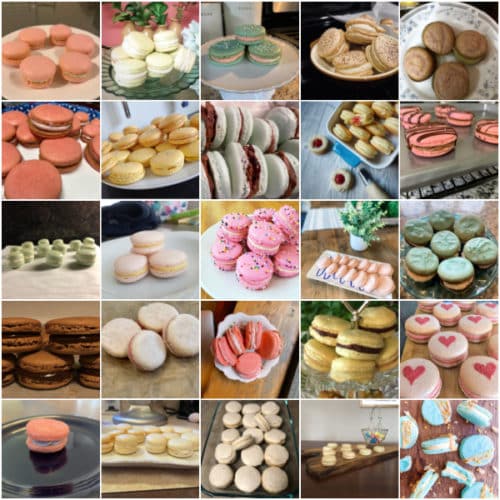
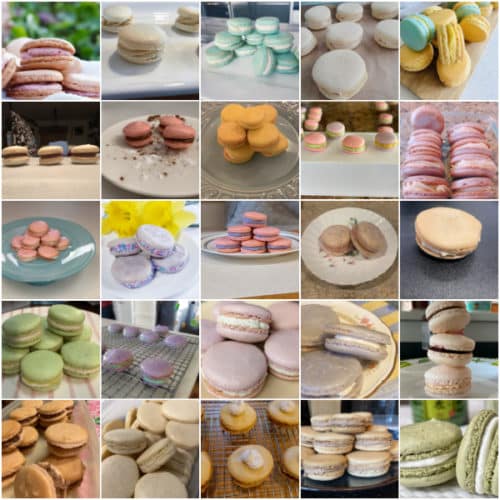

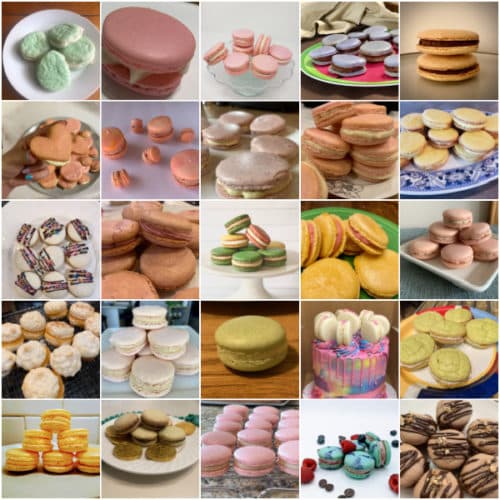
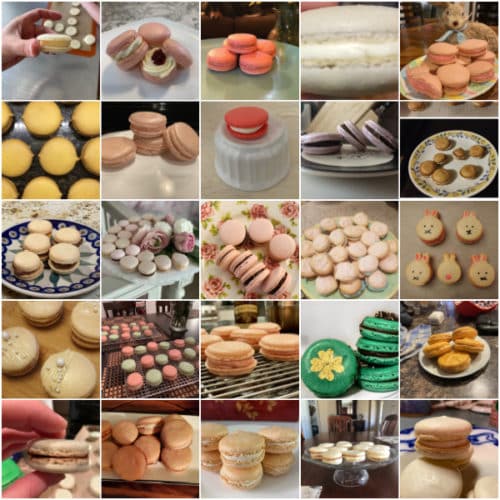
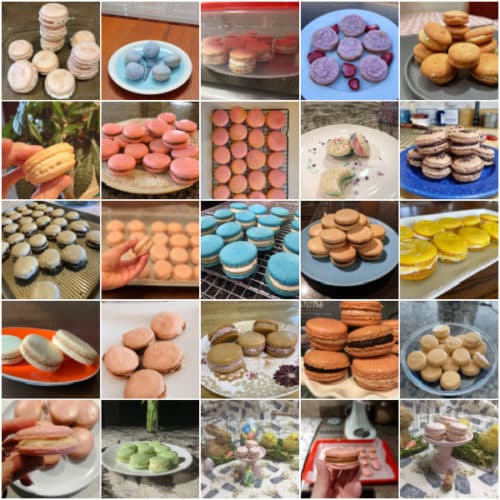
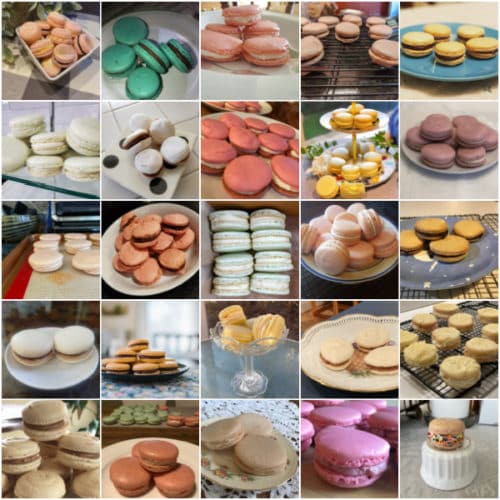
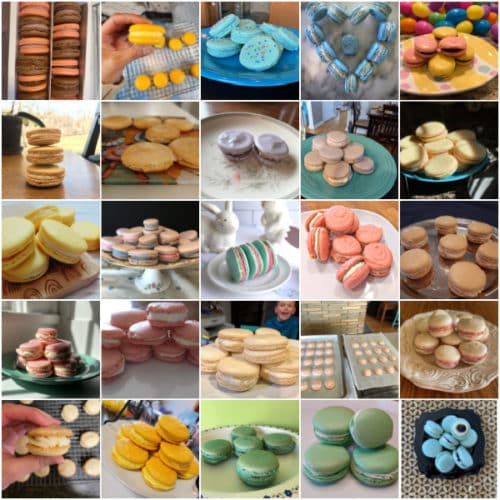
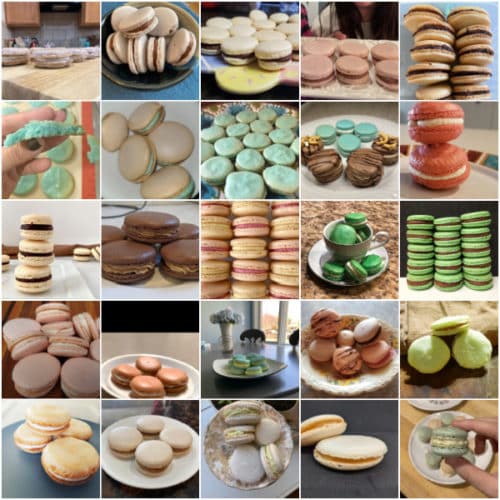
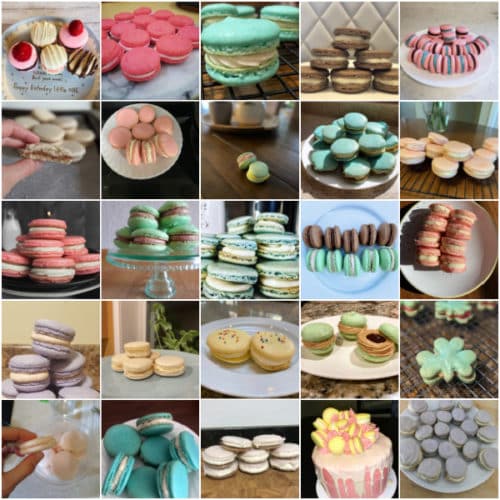
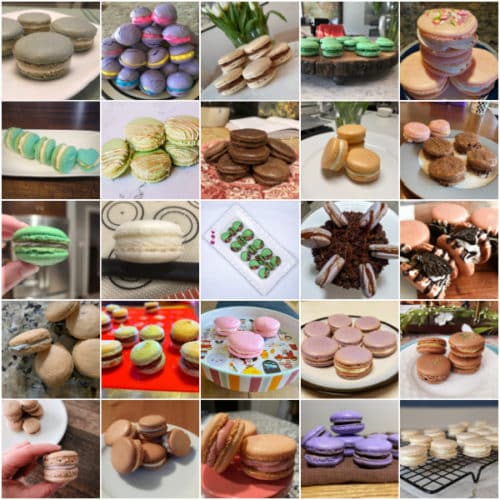
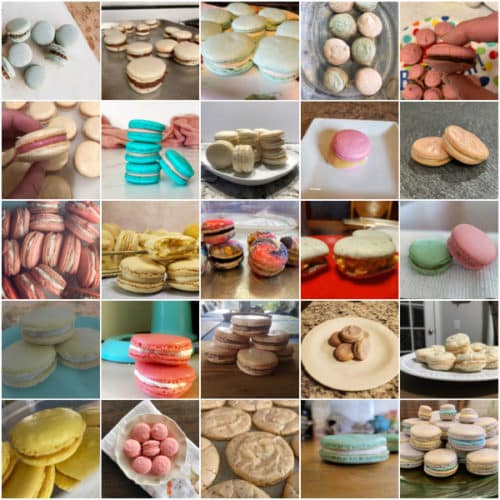
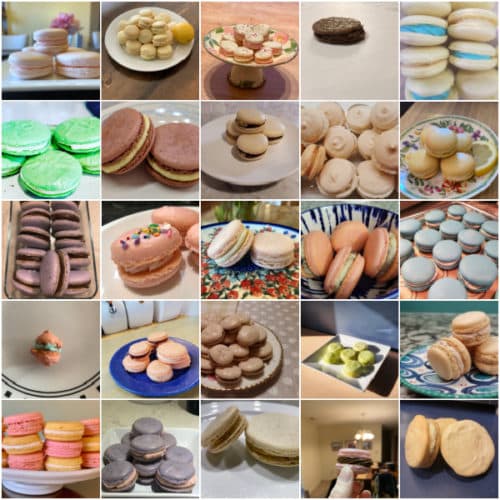
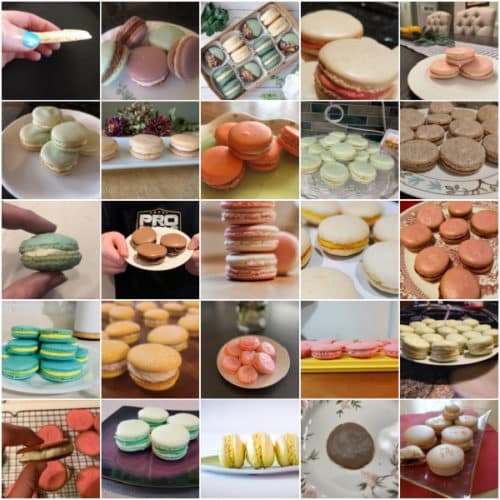
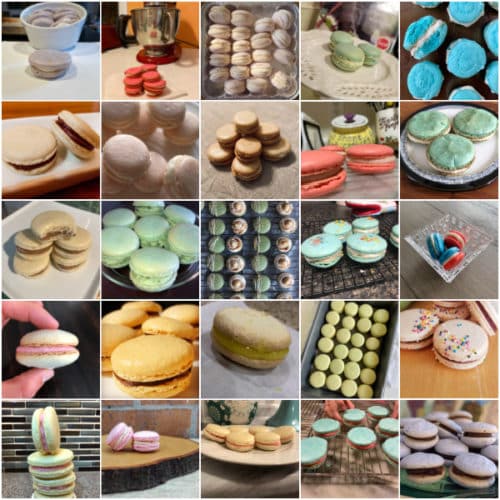
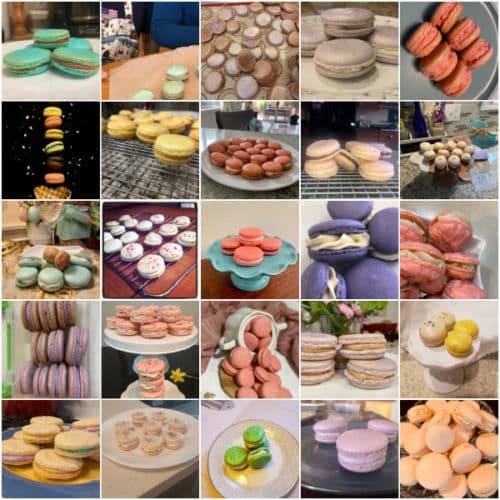
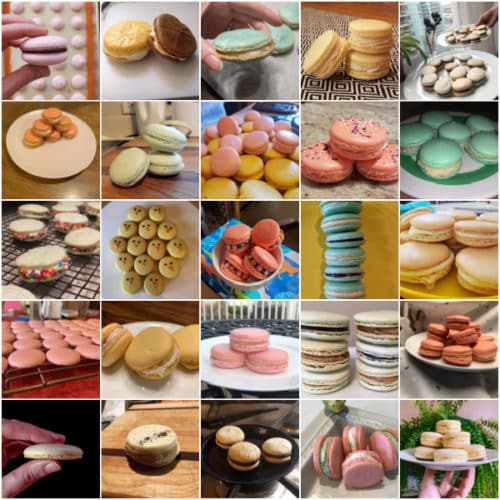
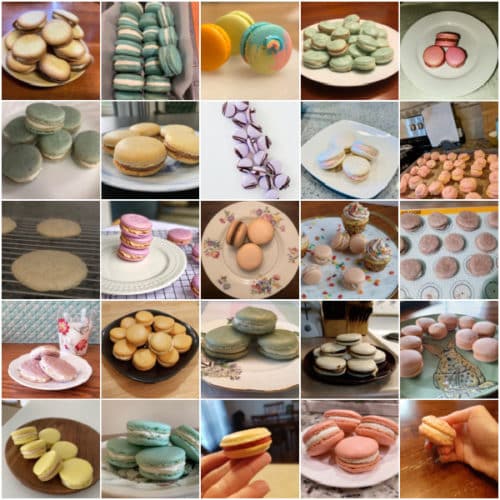
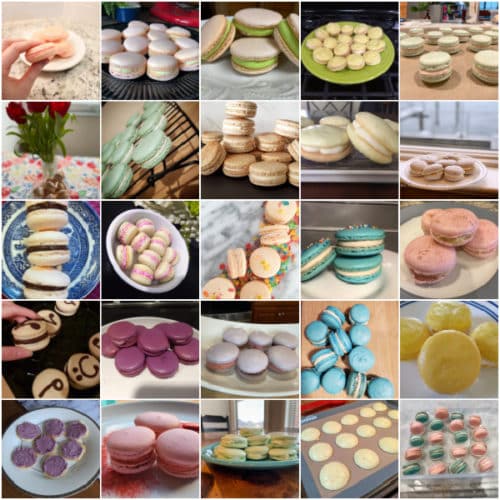
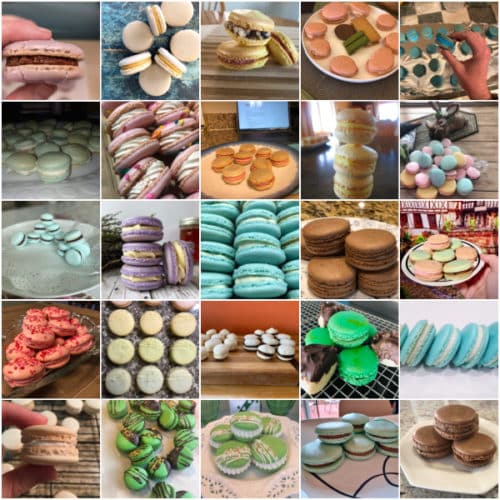
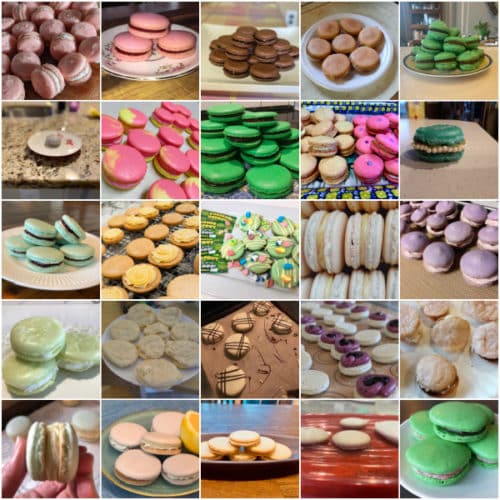
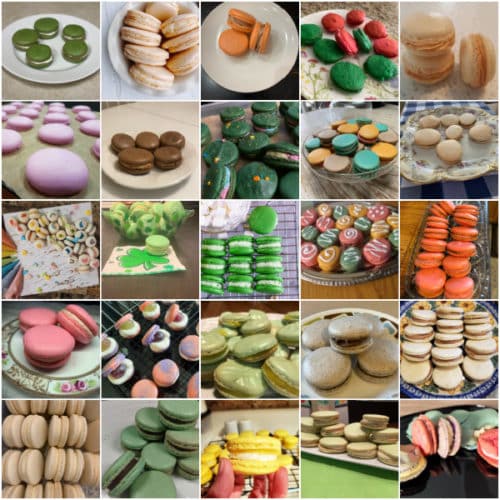
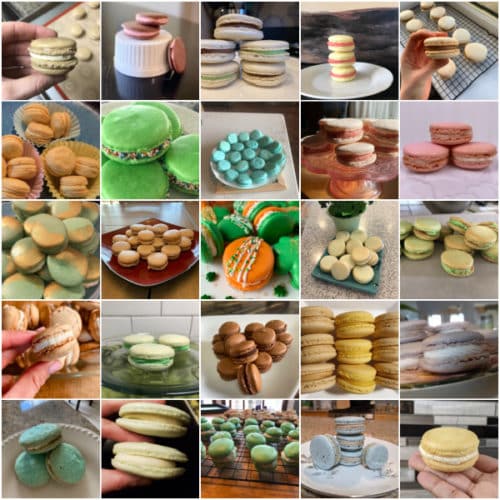
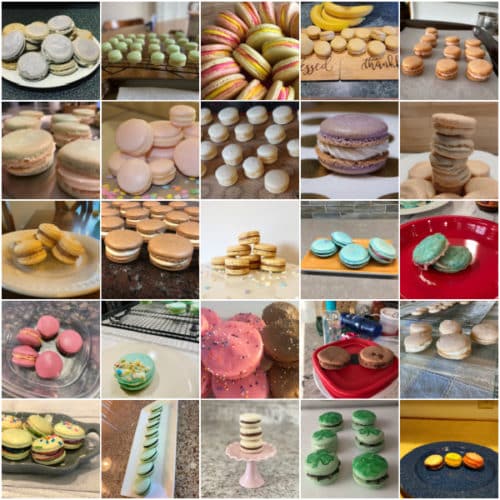

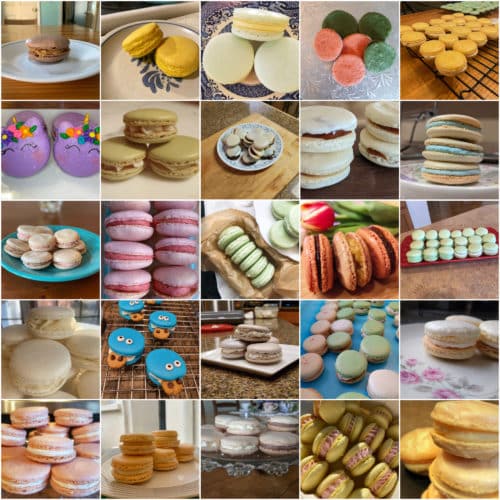
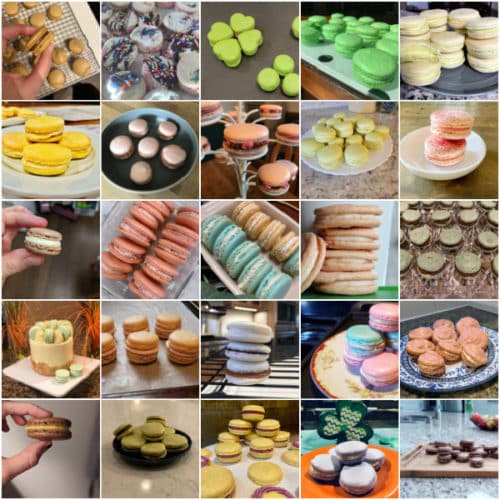
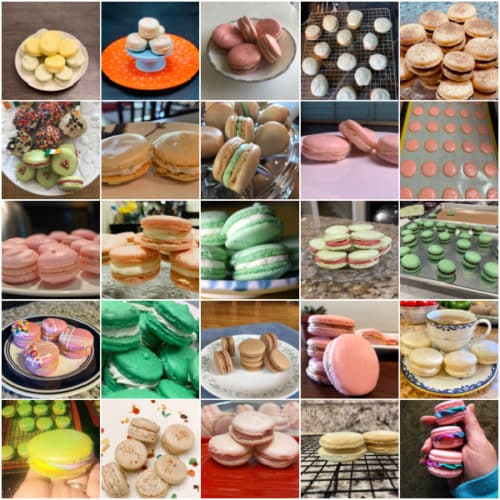
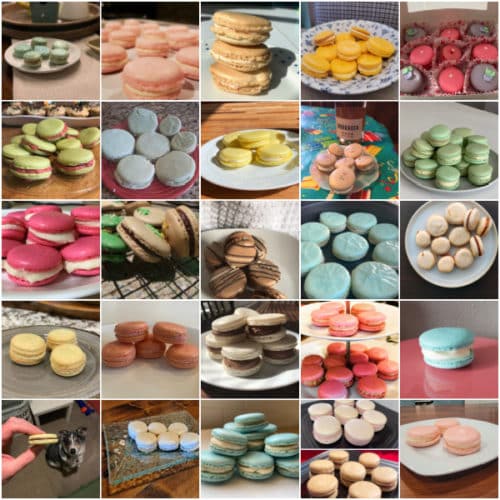
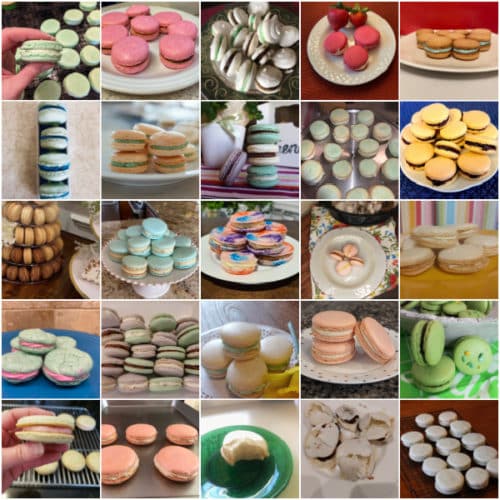

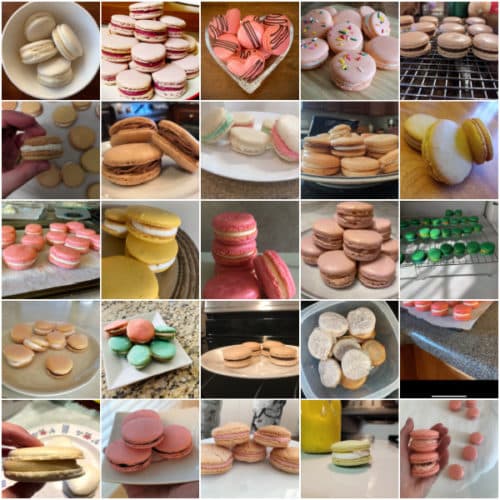
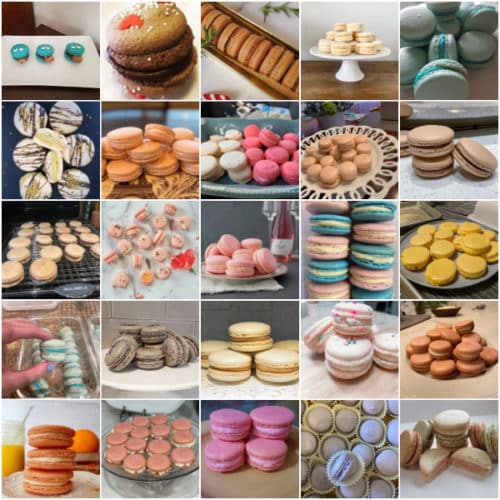
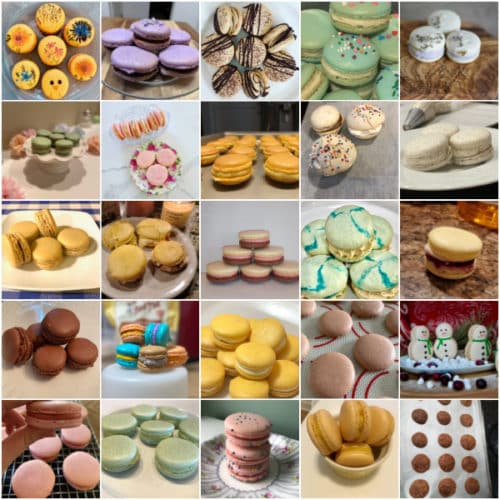



















Is it possible to split the recipe in half to to test it? would that yeild bad results?
Hi Desiree, since this is such a precise recipe, we really recommend making the full batch as written.
Hey I was wondering if I could substitute the meringue with aquafaba with no problems. Thanks!!
Hi Grace, we haven’t tested it. For best results, we recommend following this recipe as written or find a recipe that was specifically formulated to use aquafaba — macarons require precision!
l loved this recipe so much! First attempt at macarons was an epic fail. Then I discovered your recipe. Perfection! This is my new “go to” recipe.
do you use grams or cups??
Hi Faith, measuring by weight (grams) is best for this precise recipe – as listed next to the ingredients. Enjoy!
It’s been years since my first [failed] attempt at macarons. Felt up to the challenge this weekend and this recipe and video was everything I needed to lead me to success!
That’s wonderful to hear! Thank you so much for making and trusting our recipe.
I have made this recipe sometime last year and it was perfect! I was requested to make 200 sandwiched cookies. Could you help me with calculating the recipe to make this many?
Hi Madison, for best results, we recommend making individual batches of macarons rather than doubling, tripling, etc. This recipe makes about 20 sandwiched cookies, so you’ll need 10 batches total. Hope this helps!
To make my life easier, would you say if I made a few batches each weekend until the due date (1 month and 3 days away) and freeze them until the 2 days before would work? I would fill them a day before to let them sit of course. Is there a big difference in taste when they are frozen?
Can I use coconut flour instead of almond flour?
Hi Charley, almond flour is the only flour that works in this macaron recipe. If you are looking for a nut-free macaron recipe, you could try this one by Stella Parks (we have not tried it ourselves) — https://honestcooking.com/nut-free-macaron-recipe/. Or, you can try a quick Google search to see if there are any macaron recipes specifically formulated to use coconut flour.
Hi, my macarons came out chewy which I’m told is not correct. I actually thought I overlooked them because the edges were starting to brown, but was surprised by the texture. I have an oven thermometer and cooked for the allotted 13 minutes so do you know what could have gone wrong?
Hi Brooklyn, macarons are going to be a little chewy in the centers. It doesn’t seem like you did anything wrong, however, if they seem under-baked, you could extend the bake time if you try the recipe again.
I made two batches. They were so yummy! Follow the directions and pay close attention to the MACARONAGE part that you see in the video. The first time I didn’t mix them enough and they were a mess. Also, use a piping bag for the best results. Time consuming but so worth it!
Perfect recipe, great instructions! Aged egg whites is key! Just made 3 batches of these all pretty perfect! (Lemon, raspberry and Nutella filling) I’ve been making macarons for a few years using different recipes with mixed results. ..definitely had my share of issues…hollow shells, no feet, sticking to both parchment paper and silicon mats. I often would skip the aged egg whites part because I’m often an impulsive baker (who plans a day in advance? lol) but I have seen the light …aged egg whites from now on! oh and dry warm air also important I always keep a fan on in the resting phase. Thanks for this recipe (and so many of your others!) you have become my go to reference for all things baking. Thanks for all the great tips!
C’est magnifique! I’ve had this recipe bookmarked for awhile and finally got around to trying it out recently. Was not disappointed at all. The step by step tutorial, and tips really helped the success of these for me. Small issues, on my part – I forgot to bang my pans to release the air (DUH) which also is probably why my slightly smaller shells ended up being so tall. I used a red food coloring for a light pink tone and filled them with your champagne buttercream, which was just divine. Shared them with some colleagues and friends who all raved about them. Will for sure be returning to this recipe and trying other fillings. As someone that considers themselves a pretty good intermediate homebaker my thoughts to others are these – Read, watch, prepare. I can always tell if something will turn out well for me based on how ready I am when I start. It might mean a few more dishes to properly measure things out but I always find it to be worth it. Thanks for another great recipe Sally!
It worked!! I am a really good cook, but I’m a notoriously bad baker. I went out on a limb and decided to try this recipe. I followed the instructions to a T, and they came out amazing! I still can’t believe I did it! I tinted them yellow, and made the lemon buttercream filling, which tasted incredible. I can’t wait to try different flavors and make more of them. If you have a kitchen scale and do the recipe very slowly and carefully, they’ll be great!
Great guide and great recipe, not cloyingly sweet. I ended up with 3 cookie sheets’ worth of macarons. The first two were on parchment and the third on a silpat. The silpat macarons seem to have spread more and risen less, though they still had feet. Also, it took longer for them to bake and when I removed them they seem to still be underdone. Has anyone else experienced this difference on the silpat vs parchment?
Hello! What is this in US cups? I know you said not to but I am willing to risk it.
Hi Ava, Using weights (and a food scale) is the best way to guarantee success. However if you do not own one, use the following approximate measurements: for the superfine sugar, use 1/3 cup. For the almond flour and confectioners’ sugar, you need about 1 cup + 1 teaspoon each.
After trying innumerable recipes only to find that the best one required leaving the piped batter sheets sit for 3 days, I was delighted to find an easier one that nicely worked. Calculating the timing against the weather was tricky but doable. However the shells were too sweet, and felt like the flavor wasn’t spot on. Used your splendid vanilla buttercream recipe which pairs perfectly with your vanilla cake. But it made these already too sweet cookies cloyingly sweet. I added lemon curd to the buttercream but think it also needs some lemon juice. But that won’t work for other flavorings. Normally I have a high tolerance for sweetness but this was over the top even for me.
So my question is how do I reduce the sugar in the shells? I can up the extract in the recipe to ratchet up the flavor, but what is your experience? And what would you suggest for raspberry flavored filling?
Kudos for the technique!!
Hi Susan! We don’t recommend adjusting the sugar in the temperamental shell recipe, but feel free to use a less sweet filling of your choice in the future! For a raspberry filling we would try our strawberry buttercream recipe with freeze dried raspberries instead of strawberries.
I followed the recipe to the letter and got lovely macarons with perfect feet and the right texture. I made orange-flavored shells and filled them with dark chocolate ganache. So yummy! Thanks so much for this recipe!
A few questions:
1. What changes need to be made to bake these at elevation? I made these at sea level. Our vacation place is at ~4,000 feet above sea level and I’d love to be able to make them successfully there.
2. I used ½ teaspoon of orange extract and found the orange flavor to be too mild. OK to double? What about adding orange zest? If that’s not going to ruin my macarons, how much zest would you suggest?
3. I used two drops of gel food coloring (one red, one yellow, aiming for orange) and found the color too light. Is it OK to increase the amount of gel food coloring to get a more intense color? How much is safe?
4. My only issue with the macarons I made was a wrinkly top. It was crispy, but not smooth. Any troubleshooting ideas?
Thanks again for a great recipe that explains the whys and not just the hows of macarons.
Hi Lisa, I’m so glad to help. I’m glad you enjoyed your orange macarons! I wish I could offer advice regarding high altitude baking. Without much experience, I can’t give any specific instructions. You can absolutely double the orange extract. A little orange zest shouldn’t hurt either. Feel free to add another 1-2 drops of food coloring. Extra moisture is usually the culprit when the shells are wrinkly on top– so if you add more extract and gel coloring, I would slightly reduce the egg whites by about 5g.
Where in the steps do I add the extract? I see 1/2 t extract in the ingredients but not in the instructions. I realized after I made them I never added it. They’re in the resting stage now. Thank you!
Hi Flora! See the beginning of step three for adding extract. Hope you love them!
Ooooooh I see it now! They turned out great! My almond flour wouldn’t fit through the sifter so I just skipped that. They were a bit chewy at first but after sitting for a few hours they were perfect! This was my first attempt at making macarons so I’m glad I picked a good recipe! Thanks!
Hi, I am unable to find the cream of tartar. Is there any substitute that I can use?
Hi Pallavi, Cream of tartar is usually sold with the spices. Sometimes lemon juice can work in the place of cream of tartar but we don’t really recommend that substitution here. Our old recipe didn’t include it but it really does help provide consistent results!
Is it okay if I age the egg whites for 2 days?
Hi Pallavi, we usually age them for 1 day or up to 48 hours.
I’m sure there will be some reaction to this, but I had egg whites left over from another recipe from a week ago and they still came out good. Perhaps not as high as I would have liked, but still yummy.
I followed this recipe meticulously. Weighing everything and only using the specific ingredients listed. However, when it came to my incorporated batter, I could never get it to the ‘honey consistency’. It stayed thicker than that (and I folded and mixed for quite a while. When baked they didn’t rise, had a crinkled top and little to no feet. Although they looked terrible, they were still delicious! What do you think went wrong with the dough?
Hi Ashley, I’m glad they tasted great– that’s most important! Extra moisture is usually the culprit when the shells are wrinkly on top. But if your batter was thicker, I would assume you need MORE moisture. If you try this recipe again, I recommend reducing down to 90g egg whites. Then when it comes to folding the batter in step 5, keep folding until it thins out as necessary.
hi! would like to try out this recipe but may I ask what brand and type of almond flour as I saw there are extra fine, fine, super fine almond flour and heard that the finest of the flour matters! hope to get the reply soon!
Hi Sharmine! See the blog post above – we recommend fine almond flour. We use and love Bob’s Red Mill brand!
How much cocoa powder would you add to this recipe to make chocolate macarons? I have left over coconut buttercream frosting and wanted to make more of an Almond Joy/Oreo type of macaron cookie.
Hi Nikki, We do have a recipe for chocolate macarons that you can follow (feel free to use a different filling). Or we also linked a different recipe above under “Further Reading and Fun Flavors.” Let us know which one you try!
I looked at the other macaron recipes mentioned here and elsewhere to guesstimate how to adjust the recipe for chocolate macarons (I realize that’s the opposite of what you should be doing with macarons, but I was dead set on using this recipe since I’d already gone through the trouble of making caster sugar).
I figured just adding cocoa with no other adjustments would make the batter too dry, so I replaced 15g of almond flour with 15g unsweetened cocoa powder. The cookies tasted fine, after baking. One tray had more cracked cookies than the other, and I didn’t use a template, so I ended up with 52 bite-size macaron sandwiches instead of 20 normal cookies. I don’t think those problems were related to cocoa powder, though. Next time I’ll follow a chocolate macaron recipe, just to be on the safe side.
I loved this recipe but my shells didn’t dry. Any reason for this? Also how do I fix it?
Hi Mihika, french macarons can certainly be frustrating can’t they? So many factors play here. I wonder if the almond flour you used was too fine and it wasn’t soaking up the egg whites properly. If you want to try this particular recipe again, see if adding another 15g of almond flour helps. Additionally, avoid baking them on a humid day. Humidity never helps.
I used Bobs Red Mill superfine almond flour as this was the one I could find. Is there a different one I should use?
The first time I made these cookies they tasted amazing! I am getting the hang of making the proper circle shape and did a second batch this weekend but the batter was thick and I know I must have missed a detail, but I did a couple things different. 1st – is it ok to sift the almond flour and powdered sugar the night before? That was something I did differently to help with the prep time. 2nd – When using lemon juice to coat the bowl and wisk is it possible to use a bit too much? I put a good coating on it, maybe I need to use a little less. My egg whites came to a stiff peak and they looked like your video, if they were a bit too stiff would that make a thicker batter? Thank you for taking time to read my comments, and thank you for all the little details you provide so we can make amazing baked goods! I can’t wait to make these again this weekend!
Hi Kelly, somehow I’m just seeing your questions now– apologies for that! I’m glad to help. Yes, you can prep/sift the almond flour and confectioners’ sugar the night before. Cover and keep at room temperature. Go light on the lemon juice. If the egg whites are too firm and stiff, it will absolutely yield a thicker batter. If a too thick batter was a concern, aim for slightly softer peaks next time.
Thank you for the recipe. I initially used four eggs and found the batter was noticeably too thick. Tried and failed – the macarons were too high – not the right shape at all. Based on other notes I see we can reduced the flour and sugar to 110g each. I am at high altitude (7200 ft) and low humidity. Are there other adjustments you recommend?
Hi Pat, I wish we could help, but have no experience baking at high altitude. Some readers have found this chart helpful: https://www.kingarthurflour.com/learn/high-altitude-baking.html
I’m very excited to try this recipe using your very detailed instructions. I’ve had macaron failures in the past but your recipes have never failed me so I am looking forward to trying!
Before I try, I do have a question. I was hoping to incorporate some freeze dried fruit powders for flavoring but wasn’t sure how much to incorporate, or whether the weight of the fruit powder should replace some of the almond flour or sugar. Have you tried this or do you have any guidance?
Hi Allie, It could work – but we haven’t tested it. Let us know if you try anything! (You could always make the macarons as written and use strawberry buttercream as the filling using any flavor of freeze dried berries for the strawberry in the frosting.)
Flawless macarons. You did such a great job researching. I followed all your recommendations, a couple of which I have not tried till now. They came out perfectly. Thank you!
I have a question about the egg whites. I make a lot of fruit curds and as a result, I frequently have leftover egg whites. I usually freeze them in glass jars and use later for pavlovas or French meringue cookies. (I read that freezing can be beneficial for these applications because it helps the proteins to relax and then build volume faster)
Do you think previously frozen egg whites would be suitable for this recipe?
Hi Jennifer, We have never tested this recipe using frozen egg whites, but we don’t see why it would be an issue. You can thaw them overnight in the refrigerator. Let us know if you try it!
I thought I remembered what I was doing and sifted the almond flour & superfine sugar. Oops. Can I add the confectioners sugar to the egg whites as a swap you think?? Otherwise I’m starting over & wasting all of this almond flour (it was a triple batch too!!!)
Mine browned a bit on the side, how come? And i did not get feet:(
Btw i used almond meal…
Can you use egg whites in carton?
Hi Ella, for best and most consistent results, we strongly recommend using fresh egg whites from a whole egg instead of egg whites from a carton.
i am about to try this recipe hope it turns out great !!!!!!!!! i bet it will
I loved this recipe, thank you for the detailed instructions, they turned out perfectly! Now I want to try some variations – I did not use caster sugar either just blended granulated sugar. No cracks either, so excited to send these as gifts to my new clients. 🙂